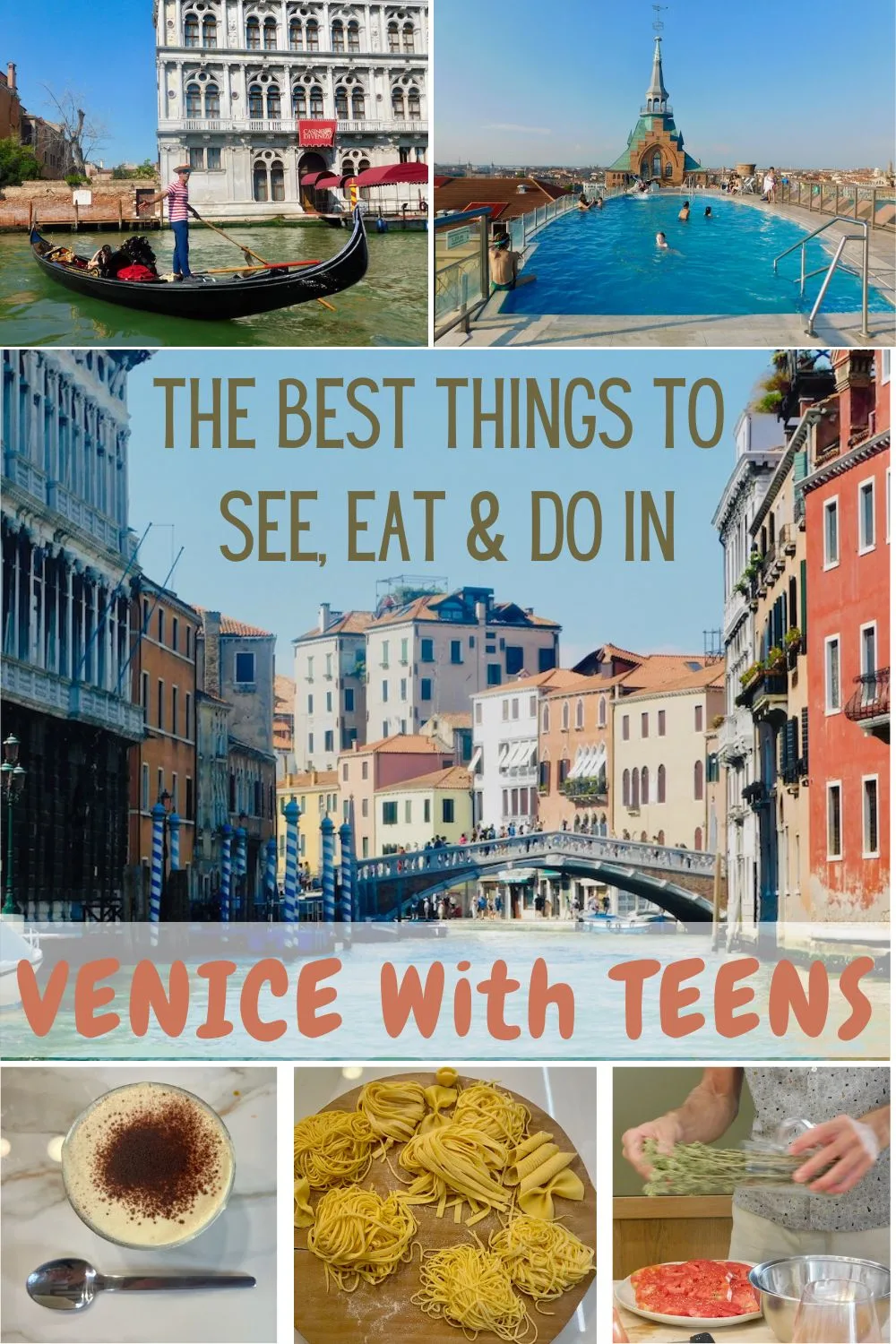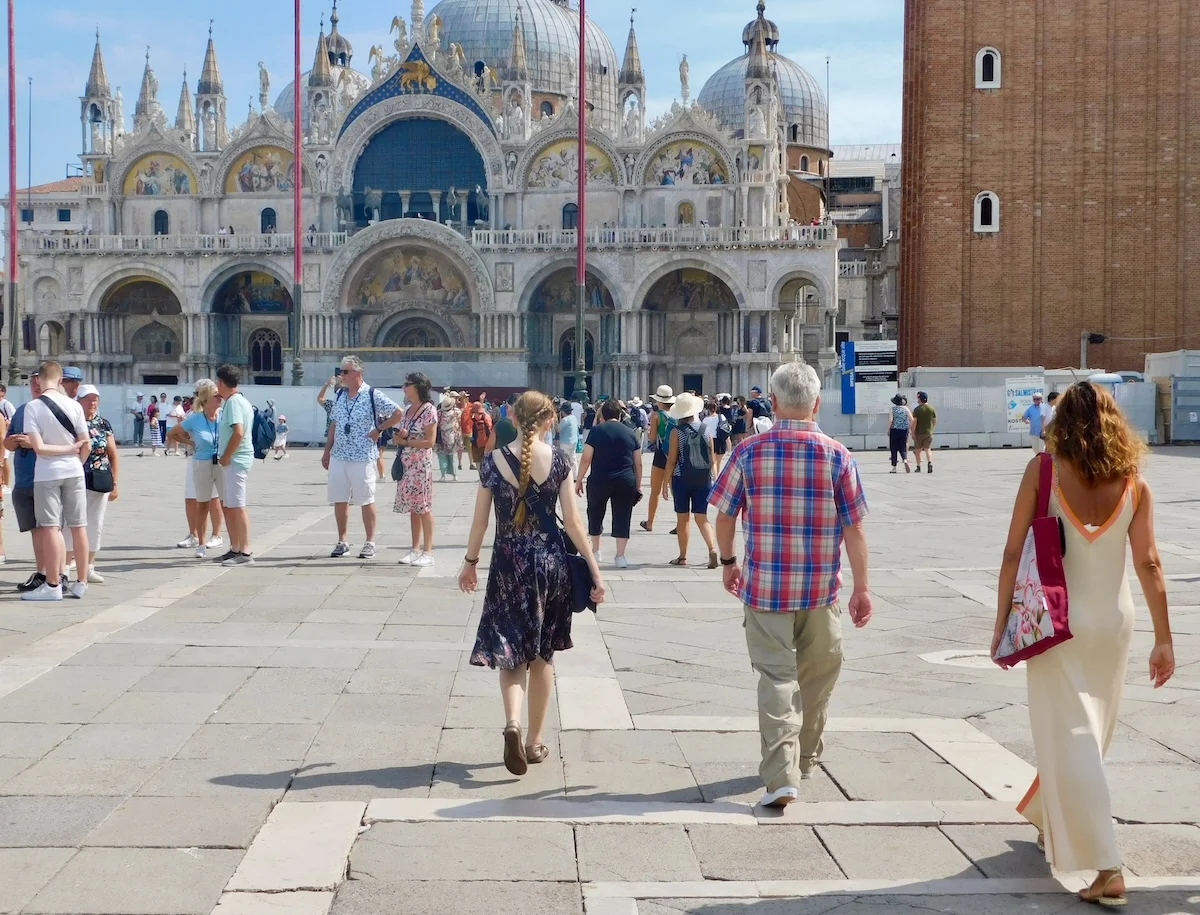Once you’ve been to Venice, Italy, you laugh at all those places that tout themselves as “the Venice of X” because they have a few canals. There is only one Venice. And it was one of the places we most wanted to visit with Teen Traveler before she finishes high school. We spent four days there last summer and it didn’t disappoint.
Here are some of the best things we found to see, eat and do in Venice with teenagers. There are also plenty of tips on what to do and what to avoid when trying to see this unique city with kids, toddlers and preschoolers. I hope they’ll help you navigate the crazy crowds and labyrinthine streets and have your own amazing visit.
Best-of-Venice To-Do List
• Best Hotel With a Pool: Hilton Molino Stucky through TripAdvisor.
• Save money with airfare and hotel packages via Expedia.
• See all of my readers (and my) favorite Venice Tours on Viator.
• Best Splurge: take a water taxi from Marco Polo Airport.
• Best thing to do with teens: a cooking class with a local chef.
• Don’t Miss: The mosaics of St. Mark’s basilica.
• Best Kid-Friendly Dinner Spot: Campo Santa Margherita.
• Best Kids Book: The tween spy novel Villains in Venice put the city at the top of Teen Traveler’s vacation wish-list.
This article is now featured on GPSmyCity. To download it or offline reading or create a self-guided walking tour, go to Walking Tours and Articles in Venice. Or read it in the app.
An Amazing Venice Hotel for Families
We booked a room at the Hilton Molino Stucky primarily because it has a rooftop pool.
It’s on Giudecca, across the lagoon from the city’s main cluster of islands, and I wondered how this would work out. But being able to escape the crowds of central Venice every afternoon for a refreshing swim was more than worth the trade-off of following a water-shuttle schedule.
We found many other things to appreciate about the hotel, too.
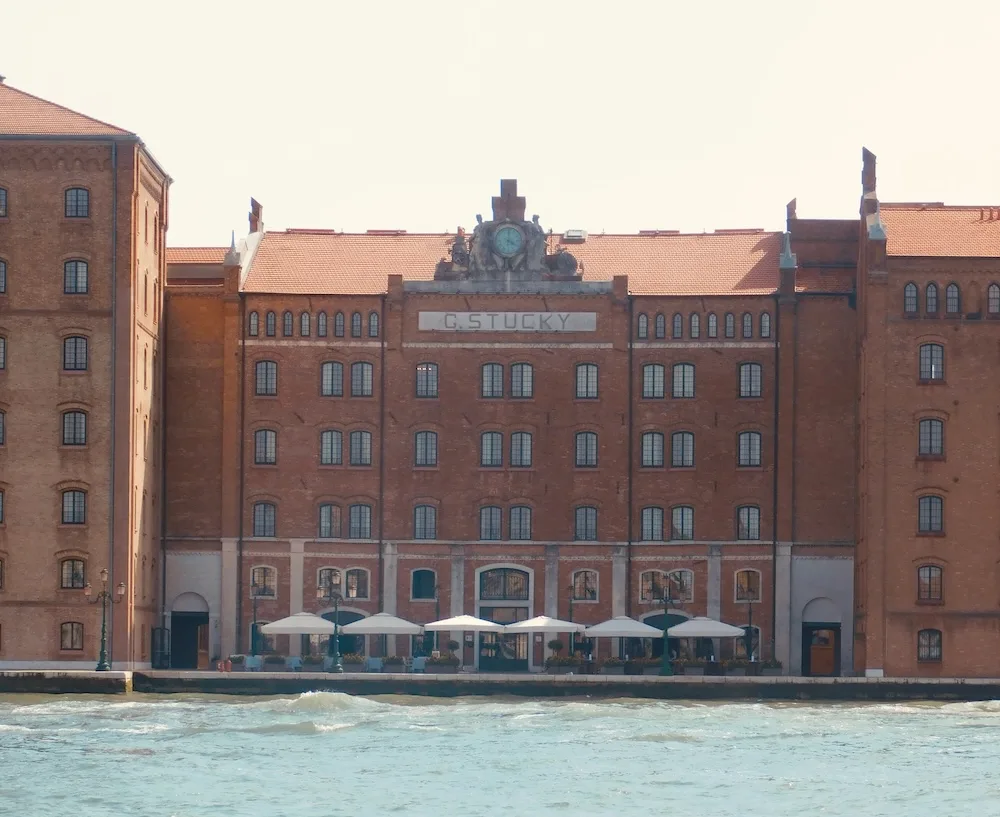
The Molino Stucky is in a former pasta factory that looks like a medieval castle from the outside. It has high ceilings, large exposed ceiling beams and big windows to let in lots of light. We liked the look and feel very much.
A wall display outside the breakfast room tells the history of the factory and the Stucky family, which conveys a lot about Venice’s history, too.
The building is the second-tallest in Venice and the roof deck offers panoramic views of the city. I went up just to take photos one afternoon. The rooftop bar next to it is a popular place for sunset drinks (though, sadly, we never got around to having those).
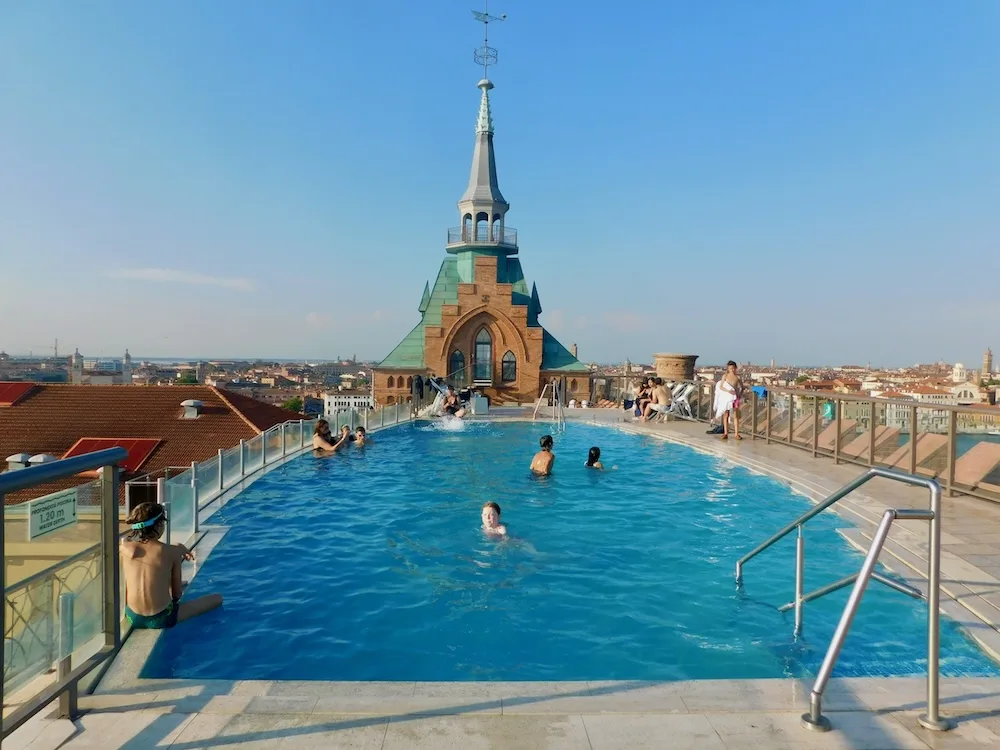
The pool was available in two-hour windows that we had to reserve in the morning. We didn’t love having to schedule our day around swimming, but usually by the time we had to head back for our reservation we were ready for a break.
If your room rate doesn’t include the breakfast buffet you can add it on for about €15 per person. I think it’s worth it, which is something I rarely think about hotel breakfasts.
Aside from fresh-squeezed juices (with optional prosecco) and authentic Italian coffee drinks, the buffet had a good mix of pastries, cold cuts, egg dishes, whole-grain breads, yogurts and salad.
A kids’ corner featured a constantly churning hot-chocolate dispenser with bright pink, yellow and blue marshmallows to add on top, which Teen Traveler took full advantage of.
We didn’t eat meals at the hotel’s other restaurants but we did stop in the Rialto bar in the lobby for after-dinner drinks and tasty gelato, which they dish out from an old-fashioned cart. The Rialto is casual, has a kids’ menu and serves food from 9:00 am to 10:30 pm, making it handy for families.
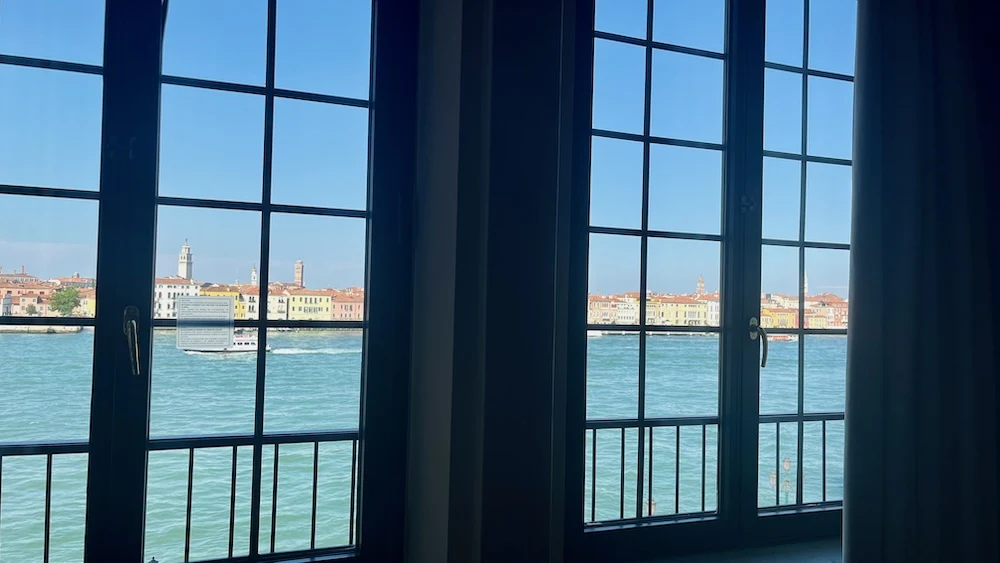
Their standard rooms have a single bed and no pull-out sofas. And the rooms that would accommodate a roll-away bed were booked when I was making my reservations in May. Luckily, we had travel points to put toward a suite with a prime view of the lagoon and the Dorsoduro neighborhood across the canal.
A large living area had a dinner table and couch. Teen Traveler had a roll-away so we could actually use the couch as a couch. The bathroom was large and modern with a deep bathtub and separate shower. There was also plenty of counter space for three sets of toiletries.
The hotel has a shuttle that runs to and from St. Mark’s Square all day and to and from Dorsoduro in the evenings. It was a flat $15 for every person older than 6YO regardless of how long you stay.
There was a vaporetto stop a short walk down the Giudecca from our hotel. It’s possible we walked more with the shuttle since we always had to start from St. Marks. But for our four-night stay, it saved us money and the hassle of figuring out all the vaporetto routes.
Read more:
• After Venice, we boarded a Mediterranean cruise on the Holland America Oosterdam
• Our first port days on the cruise were in Split and Korcula, Croatia
• We also stopped on the Greek islands of Santorini & Rhodes
• And we spent a day in Kusadasi/Ephesus, Turkey
• After the cruise, we spent 4 days exploring amazing Athens
The Best Things To Do, Eat & Buy in Venice With Teens & Kids
Our Favorite Things To Do in Venice
Take a Water Taxi from the Airport
This was our favorite experience and the perfect introduction to Venice.
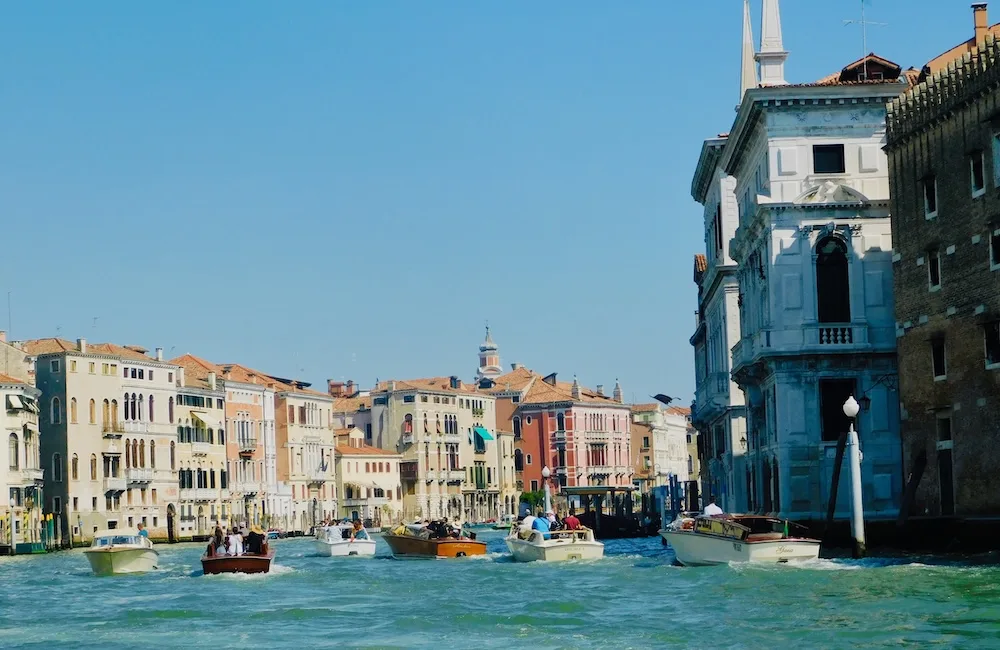
The water taxis go across the lagoon and down the Grand Canal. Standing up in the back gave us 360-degree views of the city’s grandest Palazzos and famous bridges, along with the interweaving vaporettos, gondolas, other water taxis and private boats.
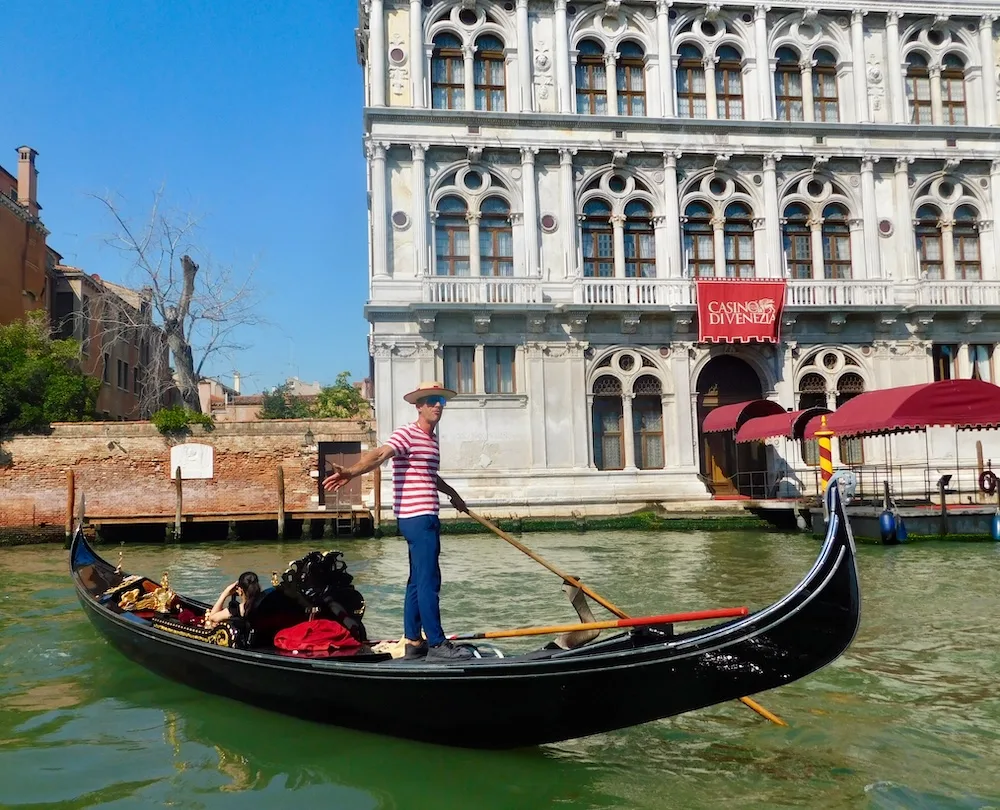
It’s the best possible view of the heart of Venice. We were grinning like idiots, taking it all in. And we snapped a lot of photos.
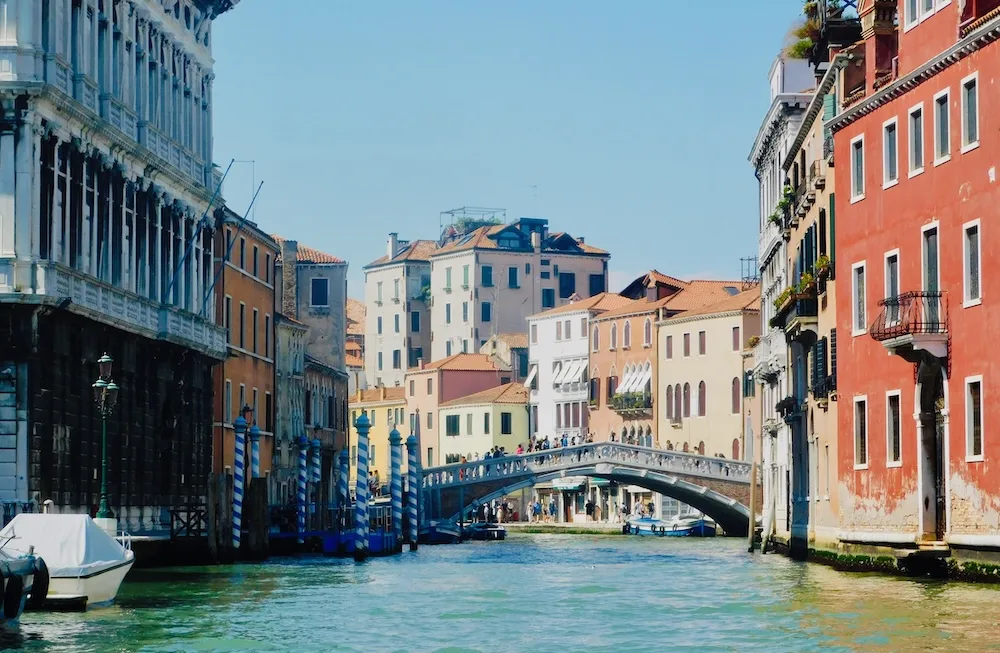
We were jetlagged and didn’t do much else the day we arrived, so we thought of this as an introductory city tour. If you are choosing one or two activities to splurge on during your stay, I highly recommend you splurge on this.
Keep sunglasses and a camera handy. You’ll want both.
Take a Cooking Class with a Local Chef
There were three sets of people in the cooking class we took and we all had teenagers aged from 15 to 19. All three of the young people seemed to get into it and I think they all wound up trying things they’d never eaten before.
Moreover, this was absolutely the best meal we had in Venice and we helped to make it.
We met our guide, a professional chef and native Venetian, at the outdoor Rialto market, where we shopped for ingredients for our lunch. He also explained what the different seafood, meats and produce were, what was local and how Venetians used various ingredients.
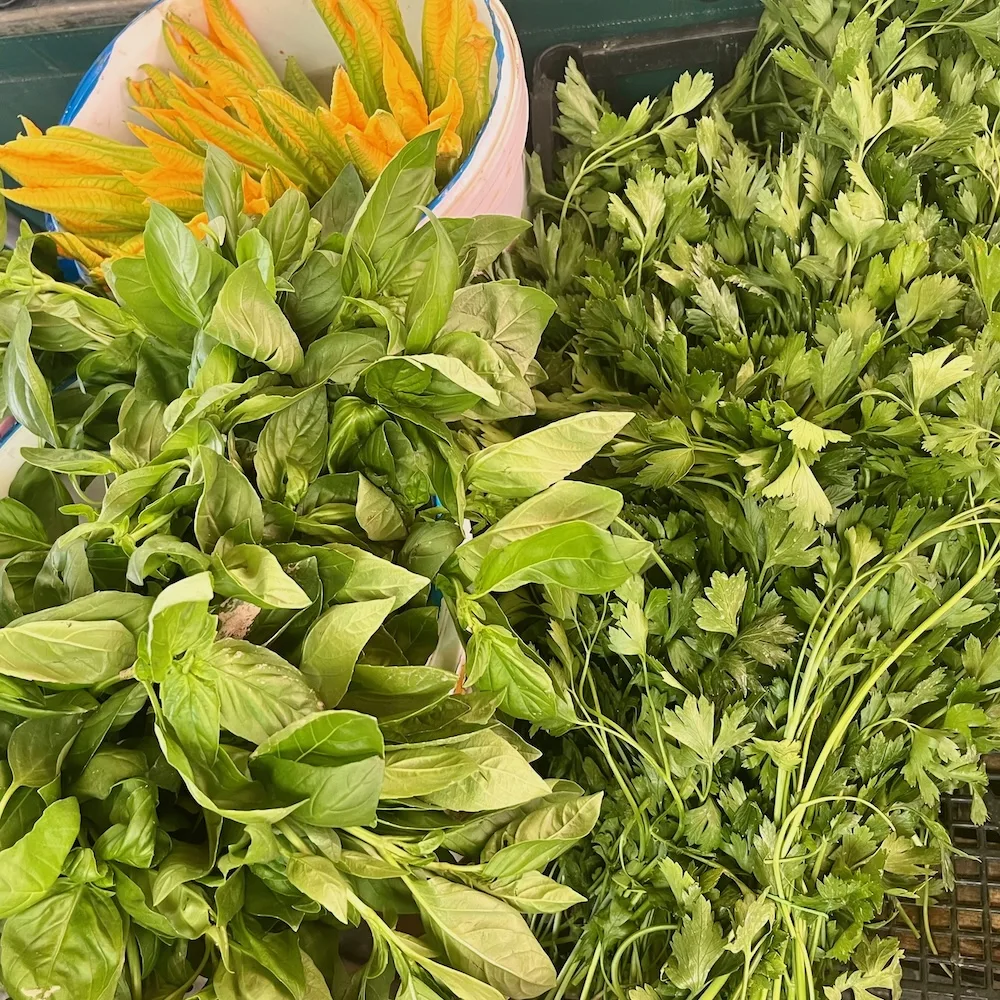
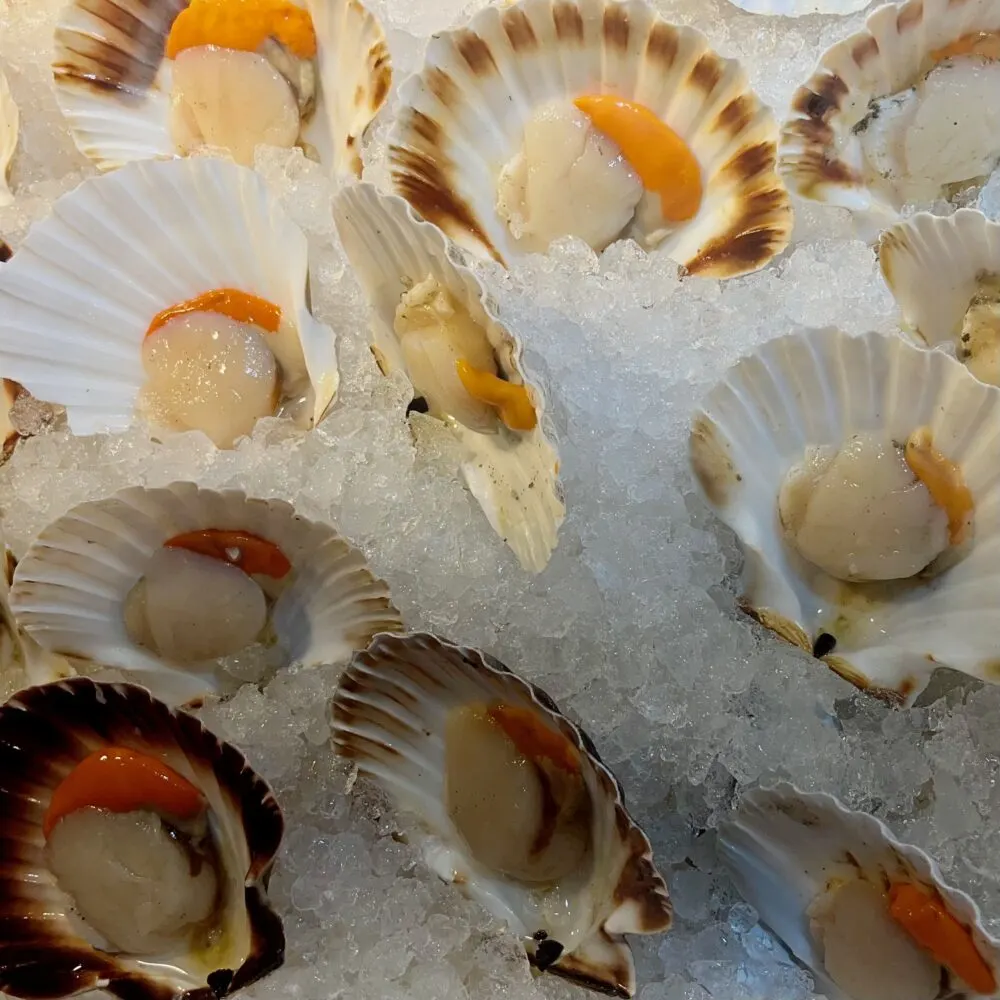
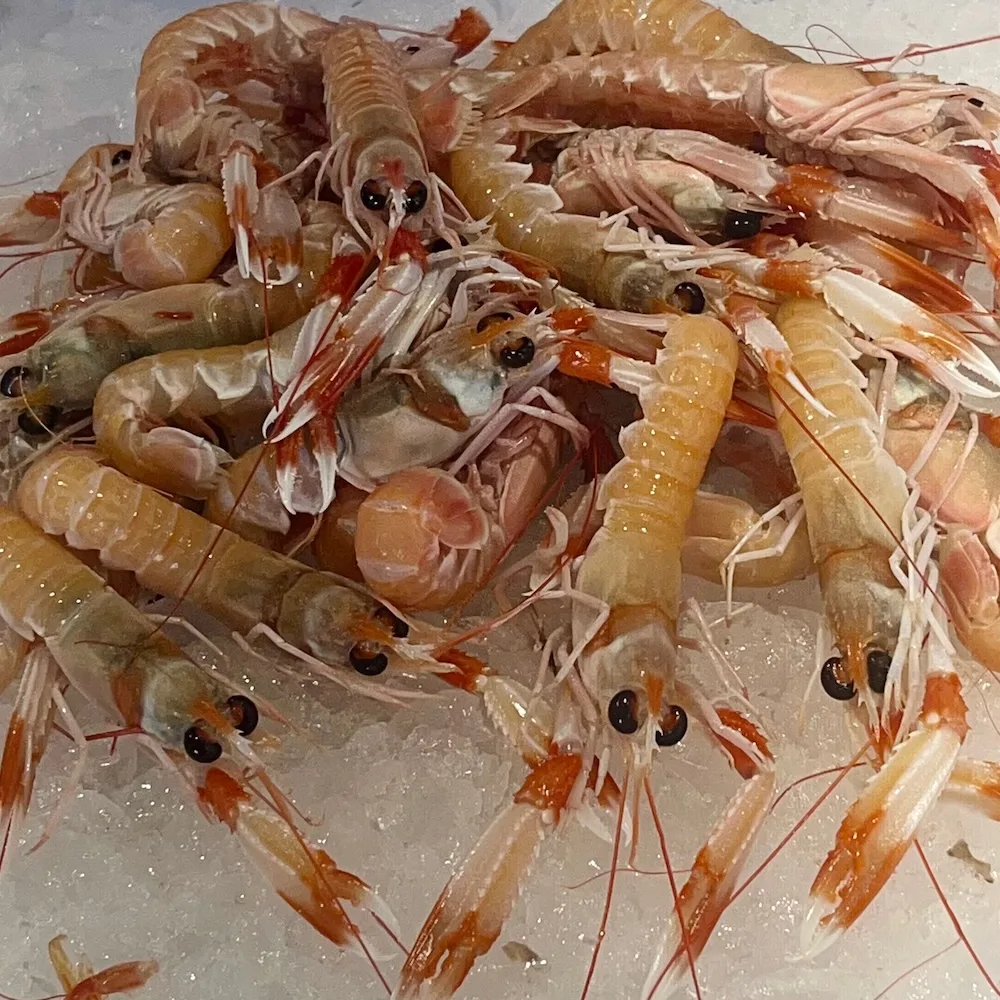
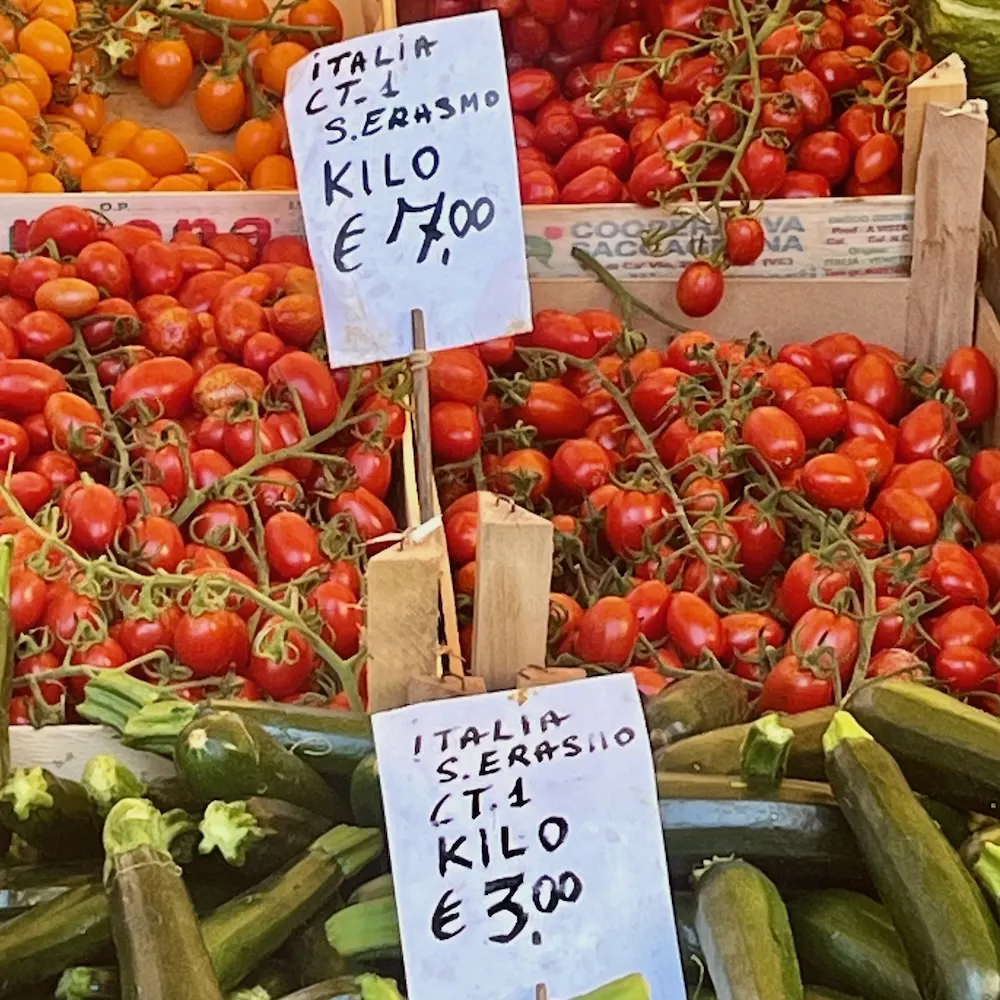
Then we walked to his house, down a tiny alleyway, where he had a kitchen purpose-built for teaching classes.
He almost always makes tiramisu. Our group pitched in on that by beating egg yolks, shaving chocolate, mixing sugar and mascarpone and layering the ingredients with espresso-soaked lady fingers.
He always teaches the group how to make pasta, too. And we all took turns making long pastas with a machine and short, hand-cut pastas. Beyond that, what he cooks depends on what he sees and likes at the market that day.
He gave us local prosecco and sopressa (dried, cured sausage) to nibble on while he prepped. Since it was the summer, we started with local heirloom tomatoes, sliced and dressed with olive oil and oregano, an interesting change from the usual basil.
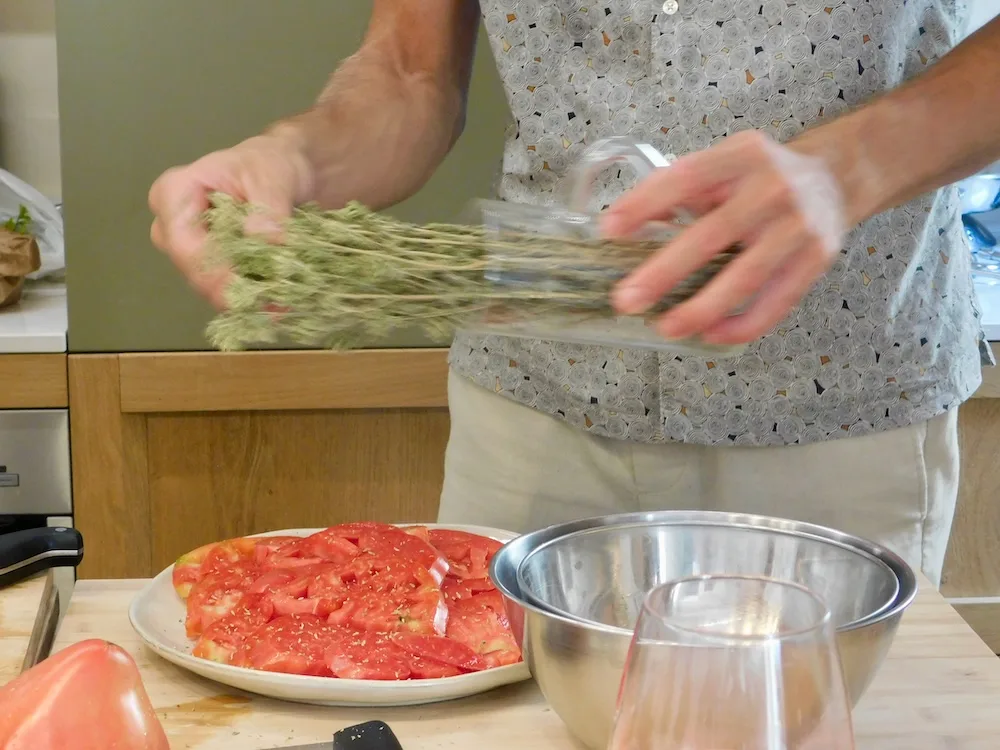
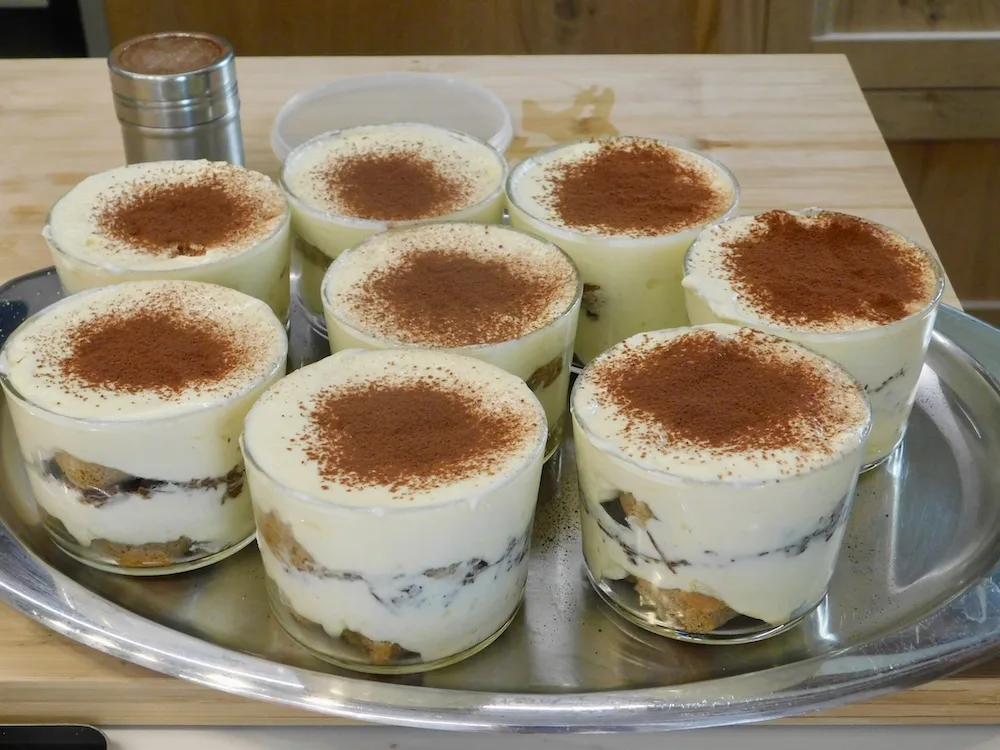
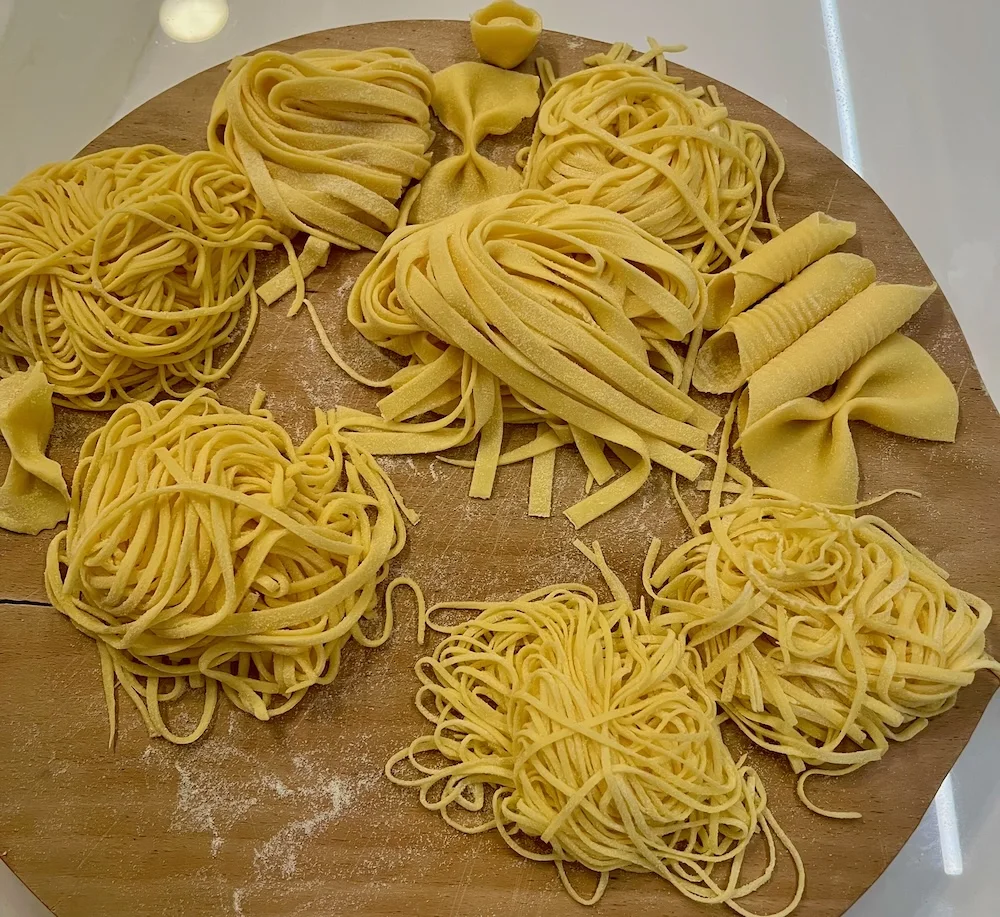
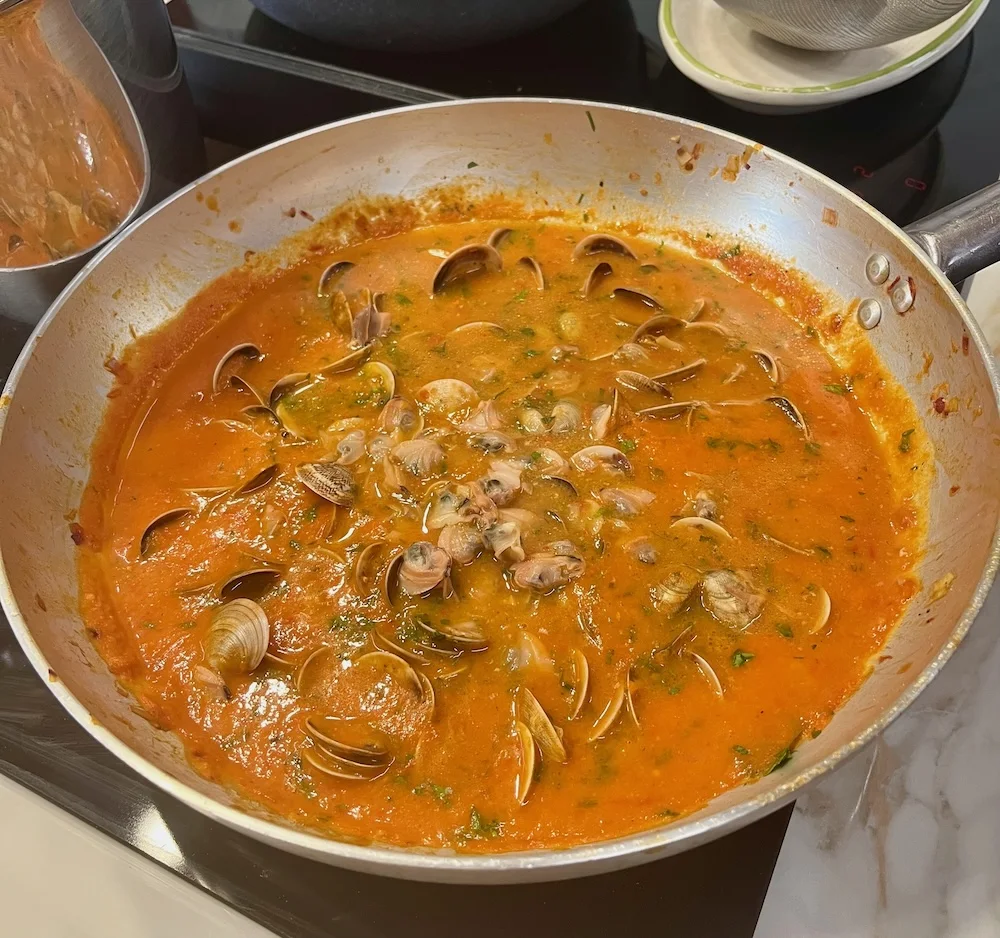
We watched him make a spicy tomato-based sauce with vongole (tiny clams) from the market for the pasta. For a second course, he made a sauce for polpette (meatballs) with browned butter, pan juices and pureed tomatoes.
By the time we finished all these dishes, the tiramisu was chilled and ready to eat.
The lesson was less hands-on than we expected and a very accomplished home cook might find some of it a little basic. But we learned new ways to use familiar Italian ingredients. And we discovered that a middle layer of shaved chocolate adds a wonderful crunch to creamy tiramisu.
I also enjoyed talking to a local and asking the burning questions I’d had on my mind, like, how do Venetian kids learn to ride bikes, where do people grocery shop, and how do they get Amazon packages delivered?
We met the chef at 10:30 and didn’t leave his house until after 2:30. Luckily, we weren’t likely to be hungry for a while. We still did some afternoon sightseeing, went swimming and had a late dinner.
Take a Free Neighborhood Walking Tour
Venice’s small, interconnected neighborhoods are ideal for walking tours. Had we stayed longer we would have booked a few. But with the limited time we had we chose a guided tour of Dorsoduro, the neighborhood that surrounds the Accademia Gallery, with Free Tours by Foot.
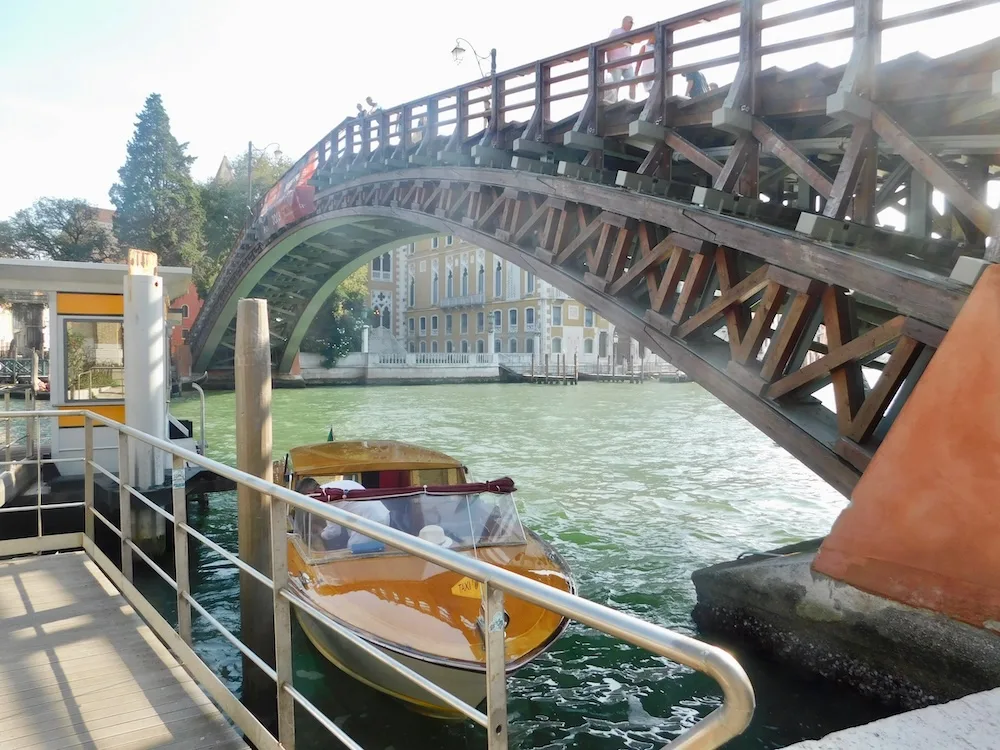
We learned about the Accademia Gallery, some of the older palazzos along the Grand Canal and some tucked-away ancient churches. Our guide also stopped in front of a cursed palazzo that has seen its long line of owners all die unexpectedly and suspiciously.
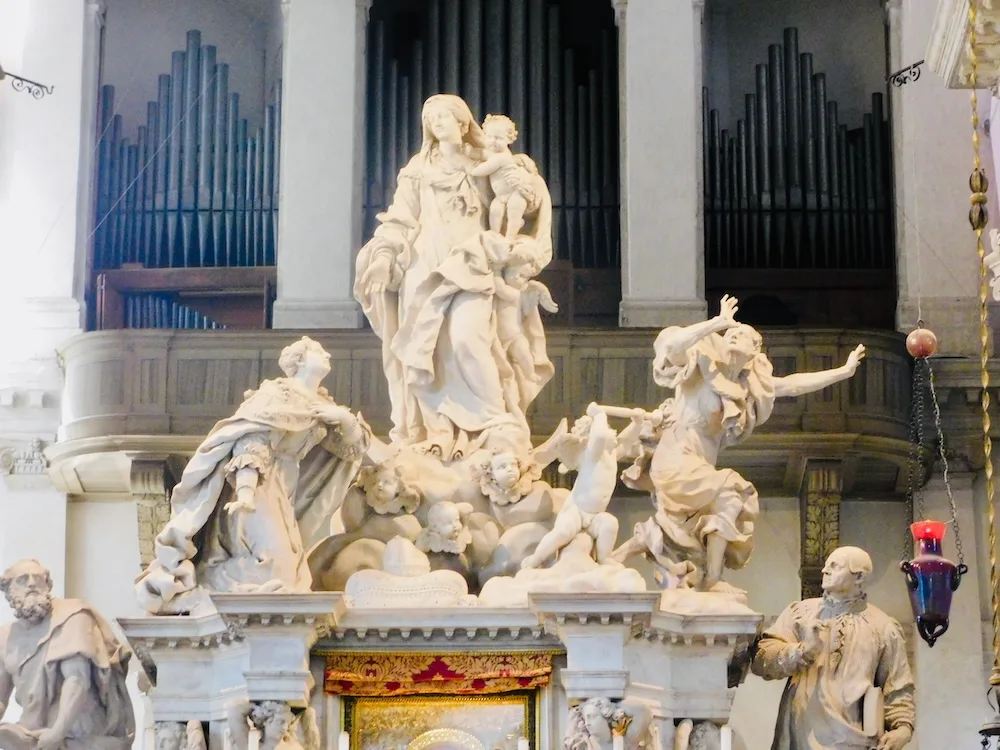
We also stopped into the domed Basilica of Santa Maria Della Salute. We ended the tour at the Customs House, on a point where the Grand Canal meets the Giudecca Lagoon, offering panoramic photo ops.
St. Mark’s Piazza and Basilica
St. Mark’s Basilica is the place where the Byzantine East and Roman Catholic Europe intersect. It’s unlike any other cathedral I’ve seen in Europe. Its marble floors and gold mosaic arches are intricate and stunning. It’s that touristy thing you really can’t miss.
After you pay a small fee to enter the basilica, there are a few optional add-ons. The one most worth paying for is access to the Loge and museum. It gives you close-up views of the church’s arches and access to the outside loge.
Once you’re outside you have all of St. Mark’s Square at your feet. The views and photos ops of the Square are fantastic.
Not surprisingly, the famous horses outside on the loge are copies. The original copper ones are in the museum that you walk through. I liked seeing them and also being able to look at some of the stone mosaic work up close. But I admit we kind of breezed through the museum to get outside.
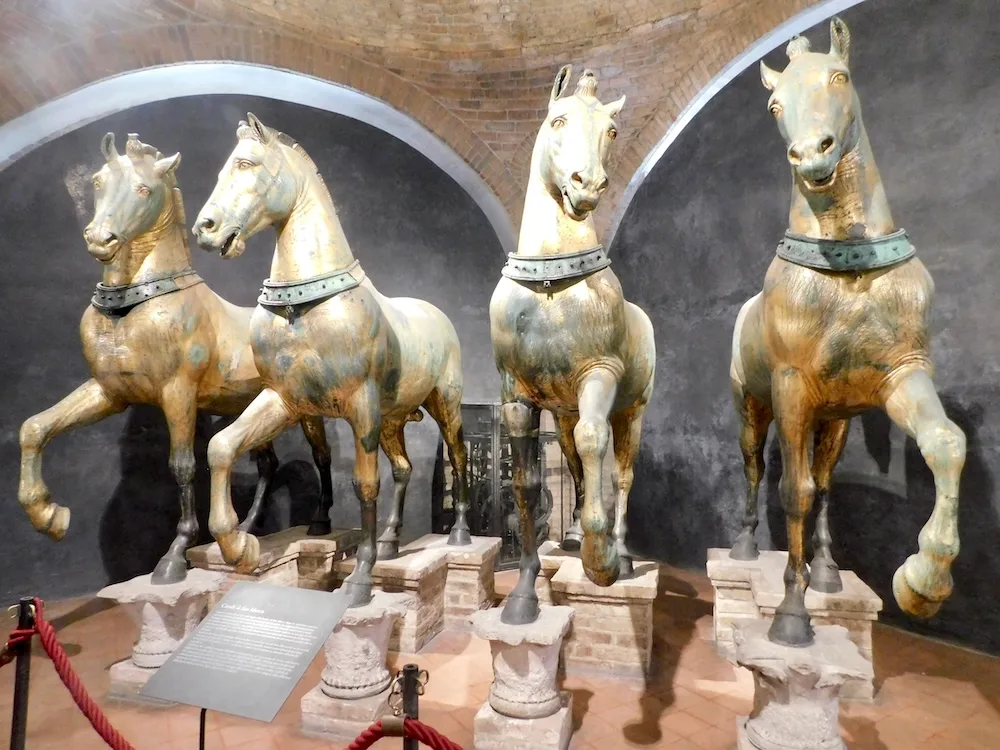
There are other add-on options, too, that are probably only essential if you are very Catholic or a student of art history.
We were satisfied with the stellar views from our hotel and the basilica loge, so we didn’t pay to climb to the top of the Campanile, which is another add-on.
Practical Information for visiting St. Mark’s Basilica: There is never not a line to get in. The lines are much shorter and move faster in the afternoon, when there is steady traffic in and out. In the morning, it takes time for the very long line to start moving at a steady pace.
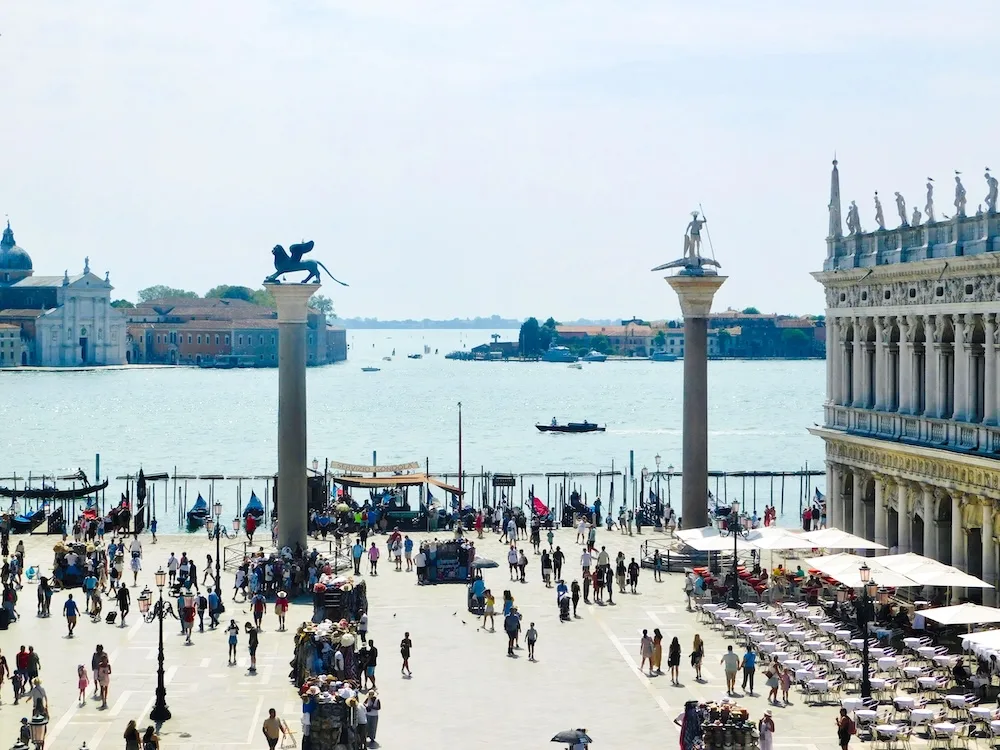
As you get near the front of the line, cathedral employees will walk up and down inspecting everyone for proper attire that covers knees and shoulders. They absolutely make people get off the line for almost all shorts, too-short skirts, tank tops, spaghetti straps and shirts or dresses with low backs.
If you aren’t sure you’ll pass muster, ask before you get on the line. Vendors around the square conveniently sell scarves for people who need to cover up legs or shoulders.
I like St. Mark’s Square at night more than during the day. It’s a little less busy and you can stroll from one café to the next to hear their small orchestras playing popular standards.
Explore the Giudecca
On our first evening we staved off jetlag with a stroll along the Giudecca’s Promenade. The island has a handful of hotels and restaurants and quite a few art studios.
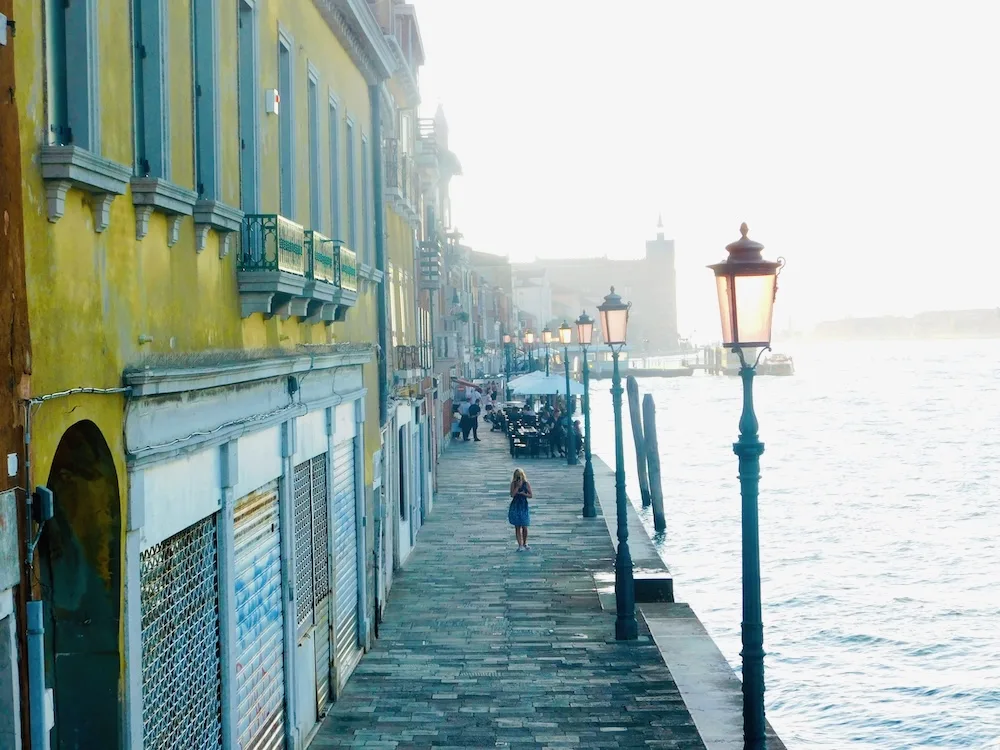
I think this is a quieter part of town generally, but it’s especially quiet in August when the Venetians who live and work there go on vacation.
Quite a few shops, studios and cafés were closed for the week. But we stopped at Riva93 Bar & Bistrot, where we had a shady sidewalk table with views of the lagoon and the city.
We wanted a light dinner and so shared a plate of fresh, fried seafood, along with salt-cod fritters and the first of several Caprese salads. For dessert we had millefoglie, which had sheets of crispy, sweet dough layered with pastry cream.
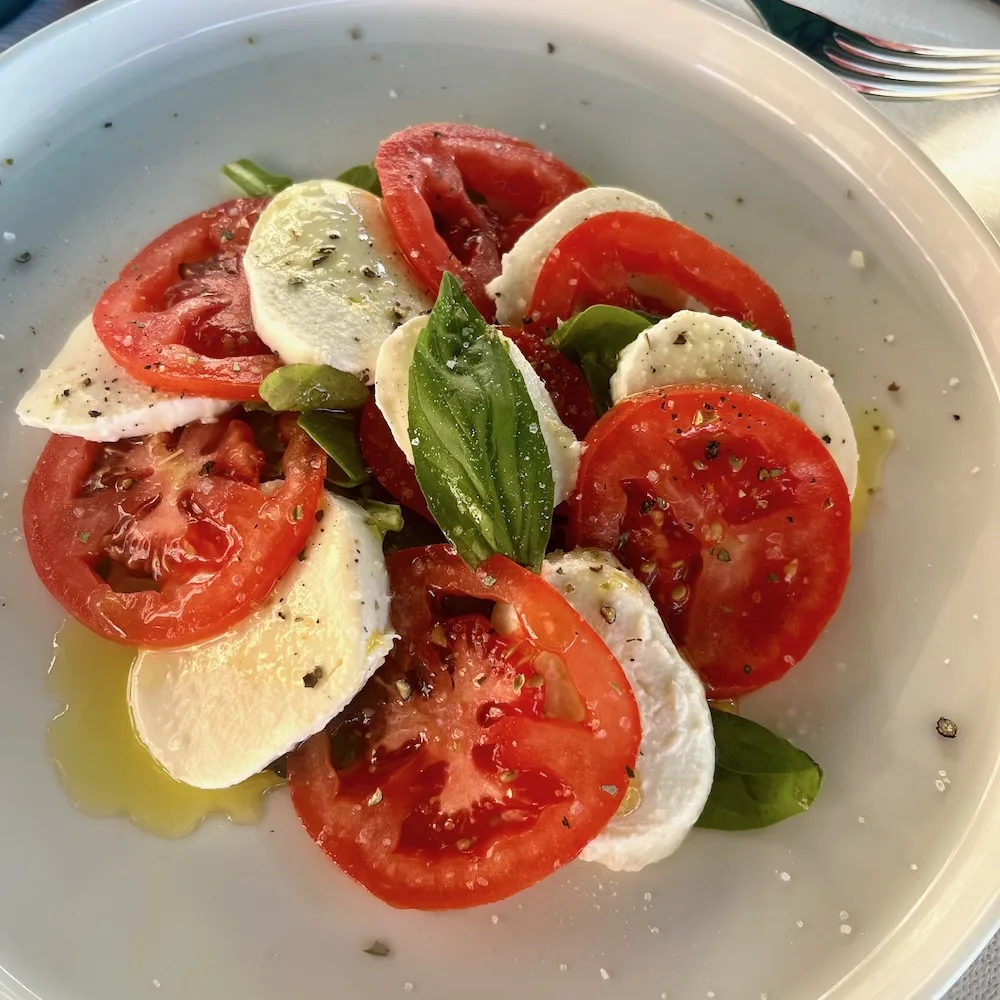
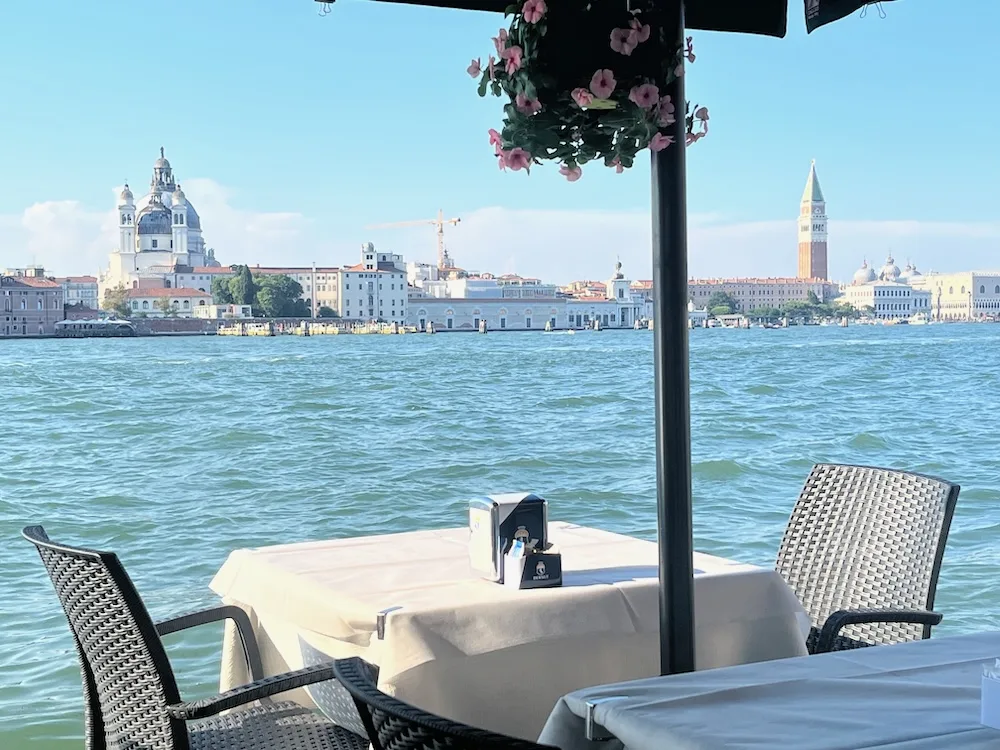
There are a few churches on the island that are worth stopping into, especially the tiny Church of Sant’Eufemia, a spare Venetian-Byzantine chapel that dates to the 9th Century.
Do Some Only-In-Venice Shopping
Inspired to visit Venice by a book she’d read in middle school, Teen Traveler was happy to spend a fair amount of time wandering the streets, taking photos of cool buildings and canals and looking for interesting stores.
Her favorite shop was Scriba, on Salizada S. Lio near the Rialto Bridge, which sells pretty leather-bound notebooks, stamps and sealing wax and Murano Glass dip pens. Teen Traveler treated herself to a pen and chose a pot of green ink to go with it.
We were drawn into Nino & Friends by the gold gondolas that were overflowing with chocolate in its window. In addition to chocolate, hard candies, candied citrus peels and other sweets, the store sells savory seasonings and spreads.
We walked out with chocolate bars for ourselves and candy for friends, creamy pistachio spread, which we have used sparingly to make it last, and aromatic truffle pesto.

In the Campo San Toma in San Polo we stumbled into La Bauta, a shop selling historic Carnevale masks and costumes, jewelry and other interesting items. We bought an old-fashioned papier maché fox mask to hang in our living room.
Near the Accademia on the Fondamente Priulla we found a similar store called Macia de Color, which had fancy masks, hats and headpieces as well as antique and handmade jewelry. Teen Traveler bought a carnevale mask stick pin, a perfect memento of Venice.
Macia has the added benefit of being two stores down from Gelateria lo Squero, which makes delicious gelato flavors like dark chocolate fondant or Chantilly cream with forest berries in small batches.
Shopping Tips: The further from St. Marks a shop is, the less expensive it will be and probably more unique, too. All the souvenirs we bought were reasonably priced, good quality and not things we saw all over the place.
There is a lot of real and imitation Murano glass around the city. Real Murano glass is hand-blown and labor-intensive. No two items will be exactly alike and they’re likely to have small flaws. If the item you’re looking at is too uniform or very inexpensive, it probably isn’t authentic.
Watch the Clocks
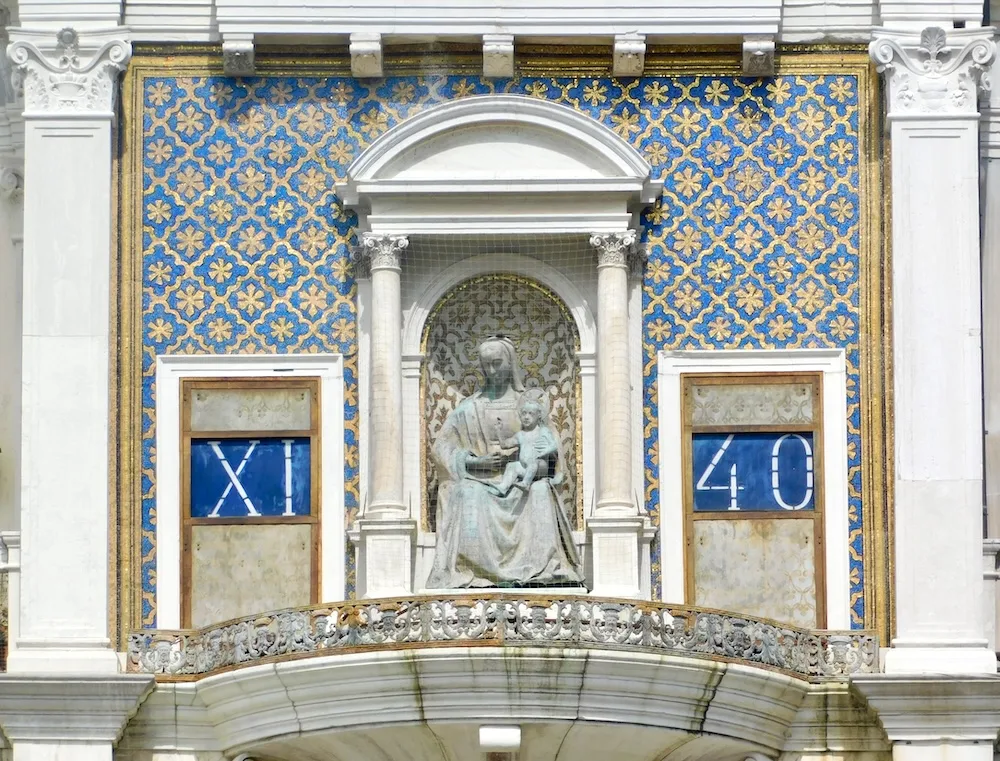
While you’re walking around town, take note of the public clocks. The Clock Tower in St. Mark’s Square has a centuries-old equivalent of a 24-hour digital clock with revolving Roman numerals marking the hour and revolving Arabic numerals the minutes.
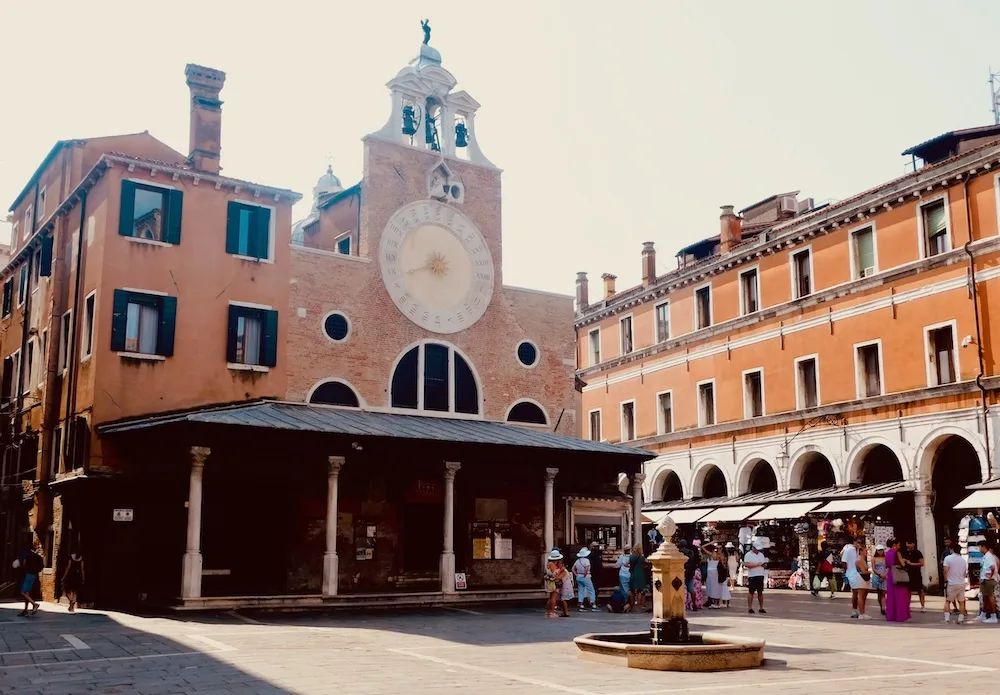
In Campo San Giacomo, near the Rialto Market, there is an analog 24-hour clock from the 15th century. I’ve never seen a clock like this and it was hard to wrap my head around until I looked at it for a while.
Things We Felt We Had To Do in Venice
The Doges’ Palace is famous and its key architectural features are copied all over the world. The Accademia Gallery is one of Italy’s outstanding art museums. Both have paintings by some of Italy’s most prominent artists. It’s hard to go to Venice and not visit one or both.
But they’re among the least child-friendly museums I’ve been to. Together they feature Venetian art that spans the 13th to 18th centuries, but it’s virtually all religious art. And they both have one-way paths through, which makes it hard to pick a few key rooms to explore and then leave, normally a good tactic with kids.
If you have little kids who will nap in a carrier, try to visit while they’re snoozing. Even with older kids and teens, plan on quick walk-throughs rather than in-depth explorations.
• The Doge’s Palace contains the Doges’ private apartment, public government rooms and the dungeons.
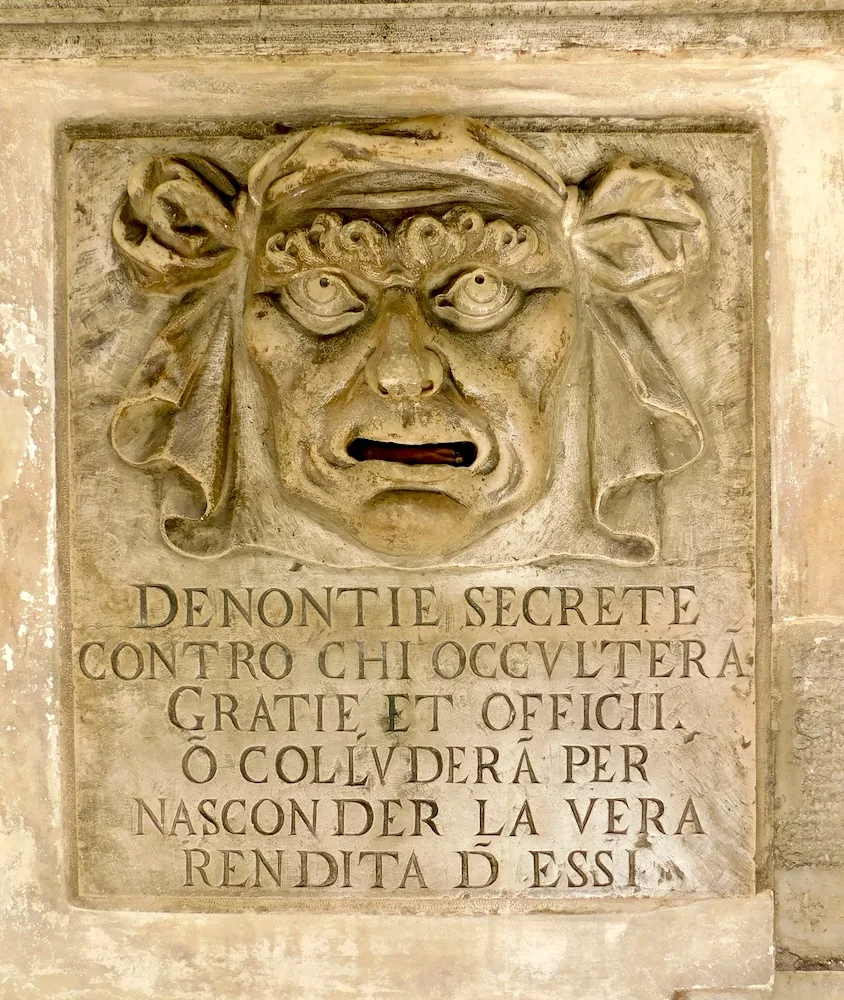
The one detail kids and teens usually find intriguing are the scary-looking mailboxes, where Venetian citizens could drop letters denouncing one another. They’re in the public corridors.
There’s no period furniture and little artwork in the apartment; it’s mostly an exhibit on the history of the doges.
The offices and meeting rooms were public and have all the impressive artwork and architectural details. An audio tour focuses on the many works by Veronese and Tintoretto, and it often left out other artwork that I was curious about, unfortunately.
Seeing the whole palace takes a good hour or two. We cruised through the last quarter because the dungeons are not very interesting. The famous Bridge of Sighs — often a prisoner’s last chance to set eyes on loved ones on the way to the dungeons — is much more photogenic from the outside.
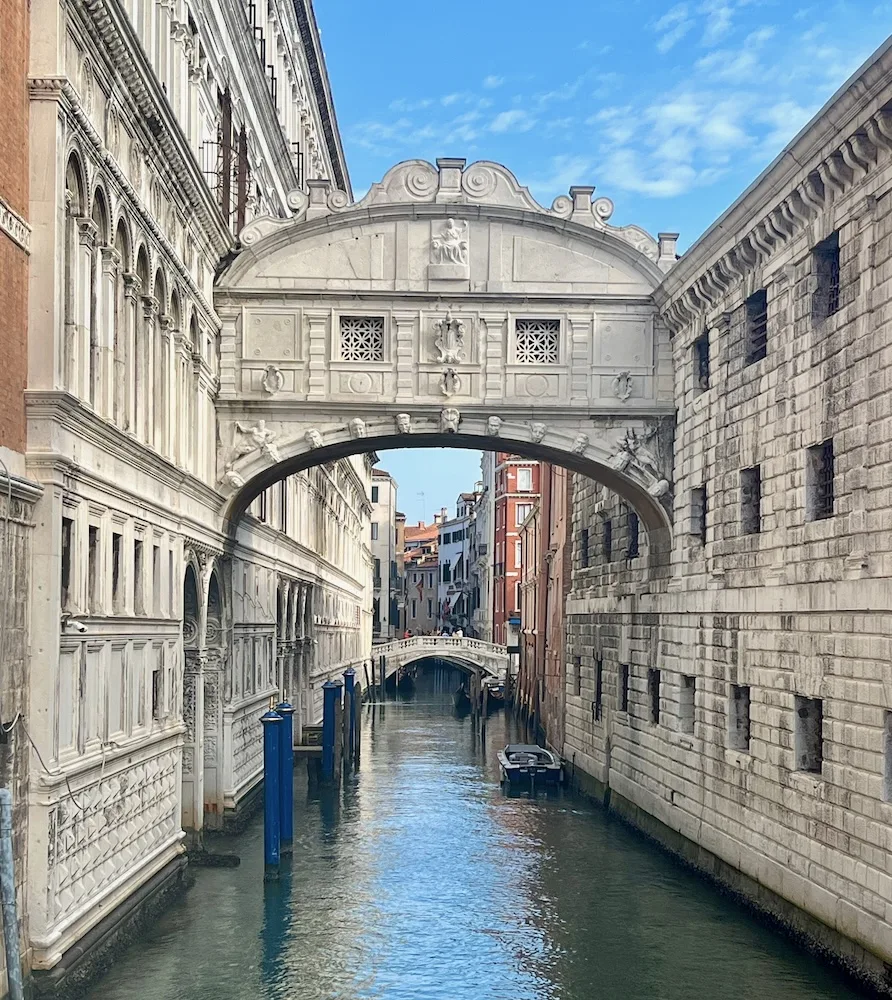
The doges had families, so wives and children lived in the palace. And of course, there was a lot of intrigue and a good dose of scandal. I think it’s a bit of a lost opportunity that the signage and audio tour don’t deal at all with day-to-day life.
Tip: A tour that is specifically for families, with games and engaging storytelling, is the way to go with elementary and middle-school kids.
If you’re planning to visit on your own, stop by in the morning. There might be no line. If there is, or you don’t have time to visit just then, you can get timed tickets for later in the day that will allow you to skip the line.
And rent the audio tour. It’s not the best audio tour and they don’t have one specifically for kids, but it’s only €5. Without it, we really wouldn’t have known what we were looking at.
• The thing I found interesting about the Accademia Gallery is that you can follow the evolution of European artistic techniques from basic, flat iconography to more elaborate and realistic portraits of people to gradually bigger and more complex scenes, both historical and allegorical.
Leonardo da Vinci’s Vitruvian Man is the one item that the casual museum-goer will immediately recognize.
Having a guide to point out the highlights of the collection and tell you why they are significant would help considerably. You can book a kid-friendly tour for this as well, that includes quizzes and puzzles to keep your kids engaged.
• Tickets to the Doges’ Palace include access to the Museo Correr in a 13th century palazzo at the opposite end of St. Mark’s Square.
/i
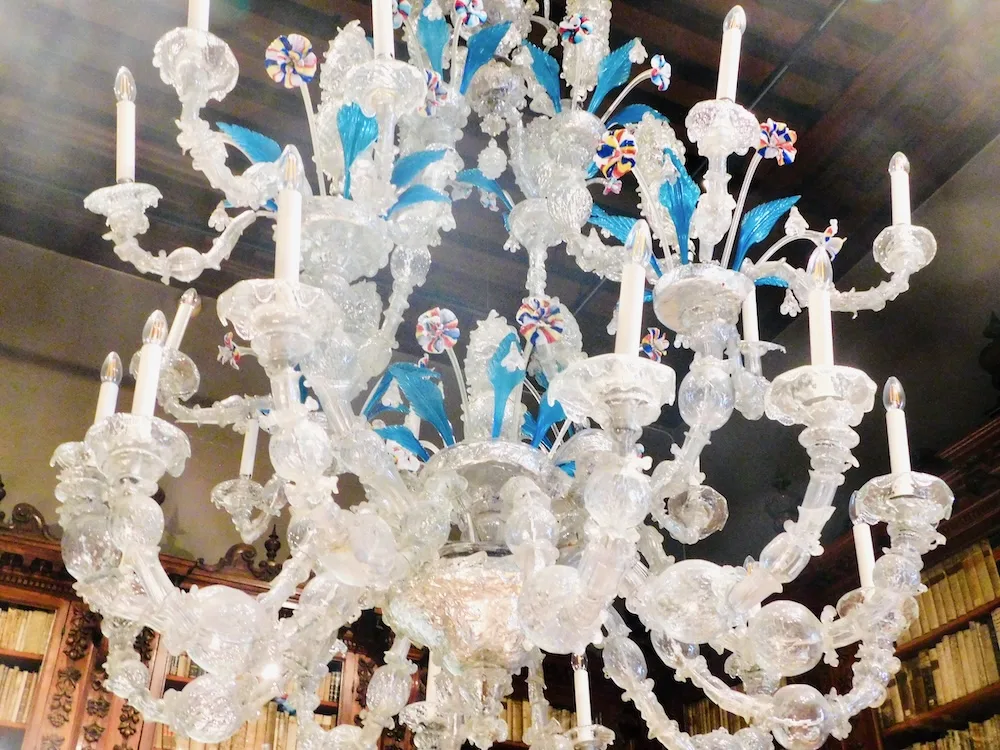
Teen Traveler actually liked this museum because it had some unusual maps and globes, including one that put the South Pole at the top. It also has a collection of fun, odd and sometimes risqué oil lamps that she found amusing. And a few rooms had elaborate Murano-glas chandeliers.
Aside from those items and a few paintings and sculptures, both the museum and the art were too baroque for me. And the explanatory signage is not as helpful as it could be. If you already have tickets and you have time to spare, you have nothing to lost by checking it out. But I can’t heartily endorse it.
Food & Restaurants We Liked in Venice
Have Dinner in Campo Santa Margherita
We stumbled upon Campo Santa Margherita while wandering around Dorsoduro on our last evening. It wasn’t in any of our guidebooks and we can’t understand why. It’s not busy, has a bunch of restaurants to choose from and is ideal for families.
It’s a wide, open campo with a large tree in the middle and no canals nearby. This is that place where your kids can get up from the table and run around. Many youngsters were doing exactly that.
You can easily keep an eye on them while you peruse the menu or linger over your last glass of wine.
There are a few touristy places (big menus in four languages), but we chose Bakaró Ristorante because it had quiet outdoor tables and a small menu that looked like local fare. It was an ideal last dinner in the city.
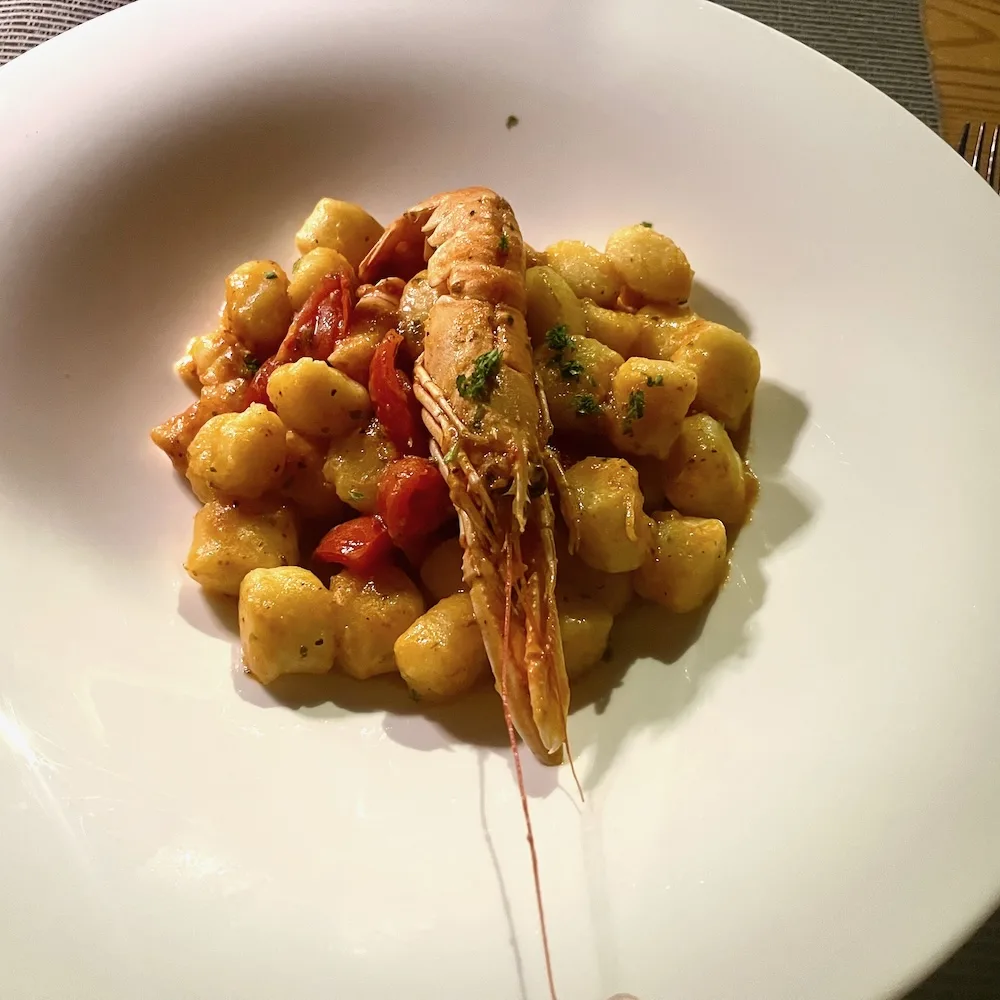
Richard got to have liver and polenta, a very typical Venetian dish that isn’t for everyone but that he really enjoyed. I had pillowy gnocchi with large crayfish (scampi) in a zesty red sauce. Teen Traveler had steak with a fruity sauce and grilled potatoes.
For dessert we had biscotti with vanilla zabaglione, which is similar to pastry cream. It was so yellow it looked like mustard, I guess because Venetian eggs have deep yellow yolks. It definitely did not taste like mustard; It was delicious.
With this and every other meal, Teen Traveler drank Italian lemon soda, which comes in cans and bottles and is fizzy, lighter and less sweet than American soda.
An Off-beat Find Near the Rialto Market
While in the Rialto Market with our cooking class we spotted a place called Trattoria Antico Poste Veccie in an ancient-looking house with a wooden foot bridge. It looked intriguing. And we figured it would have good seafood, being right next to the market.
It was a great choice. The building is a former post office. Inside it had old-fashioned fireplaces with cone-shaped metal chimneys, elaborate murals with mythological themes and amusingly tacky decorative plates from restaurants around Venice. The service was very friendly.
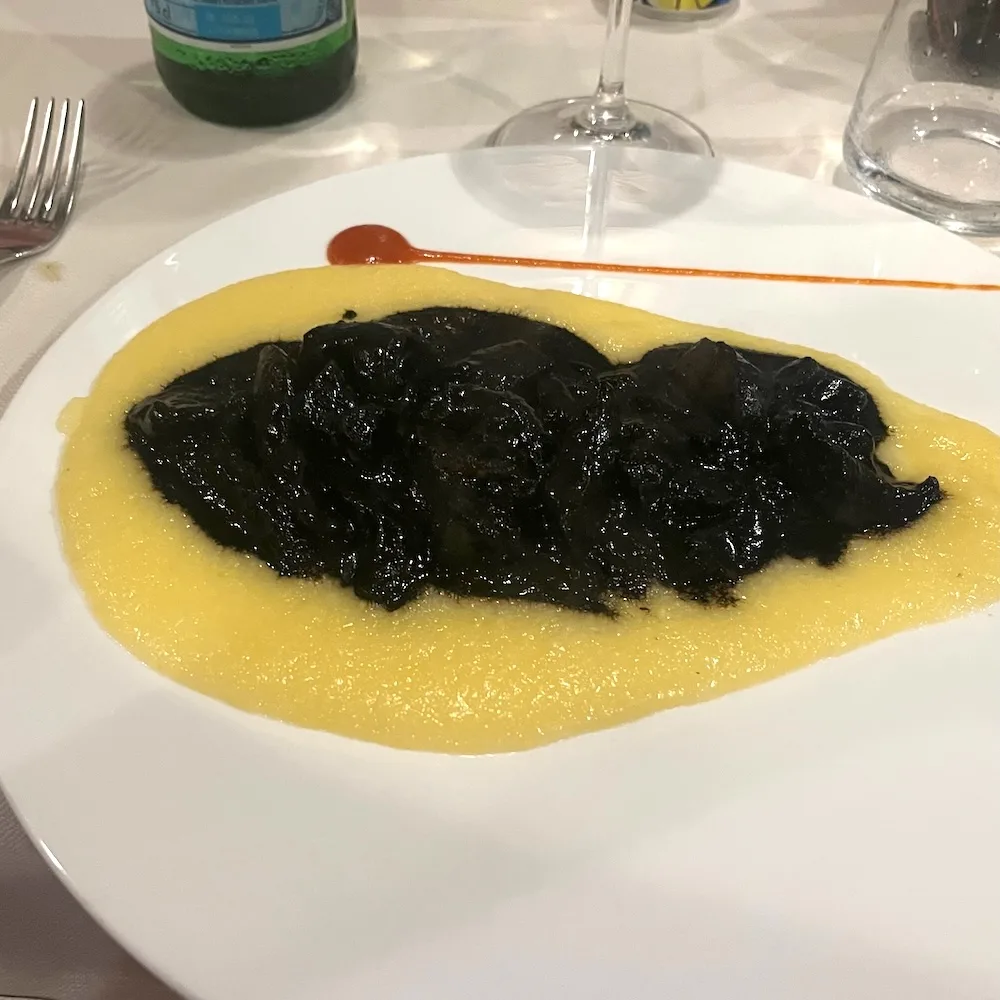
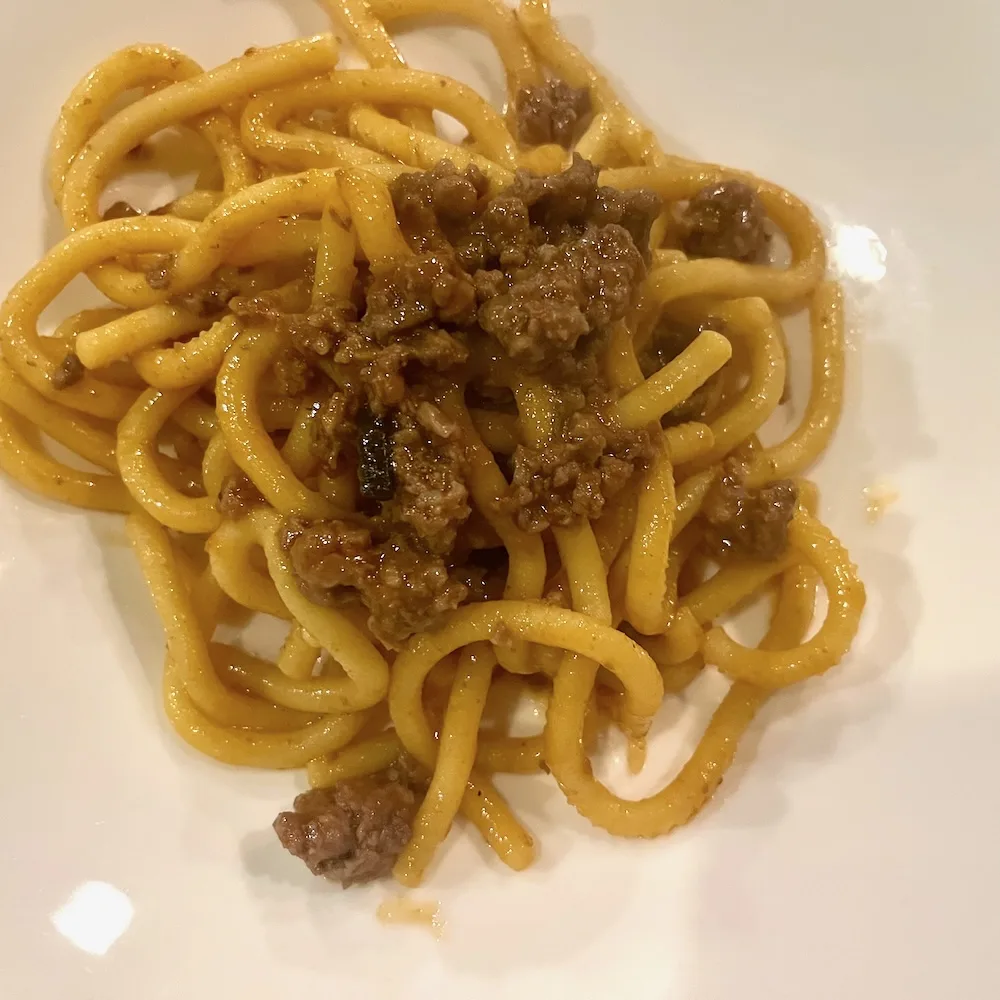
Rich had polenta with cuttlefish, another very typical local dish. The cuttlefish looks a little intimidating in its black ink. But it was tender, not chewy the way squid can be, and the polenta was perfectly creamy.
Teen Traveler and I both had bucatini (thick, hollow spaghetti) with duck ragù. The duck was ground rather than shredded, which I’d never seen before. The pasta had the perfect chewy texture you only find in Italy and the ragù was slow-cooked with deep flavors.
Tip: A Trattoria is a restaurant that specializes in the food of a city or region. In theory, any place you pass in Venice with the word trattoria in its name will serve local specialties.
I think this is likely to be more pronounced in the neighborhoods away from St. Mark’s, where restaurants want to appeal to local diners as much as to tourists.
Try Some Venetian Tapas
Cicchetti are the Venetian equivalent of Spanish tapas. They’re small bites that bars originally served alongside a glass of beer or wine. Now there are places to go specifically for cicchetti and it’s popular to make a meal out of these small bites.
Common items include rounds of bread with thinly sliced meat like prosciutto, vegetables like chopped tomato or eggplant or various spreads. You’ll also see croquettes with combinations of potato, cheese, meat, fish or veggies.
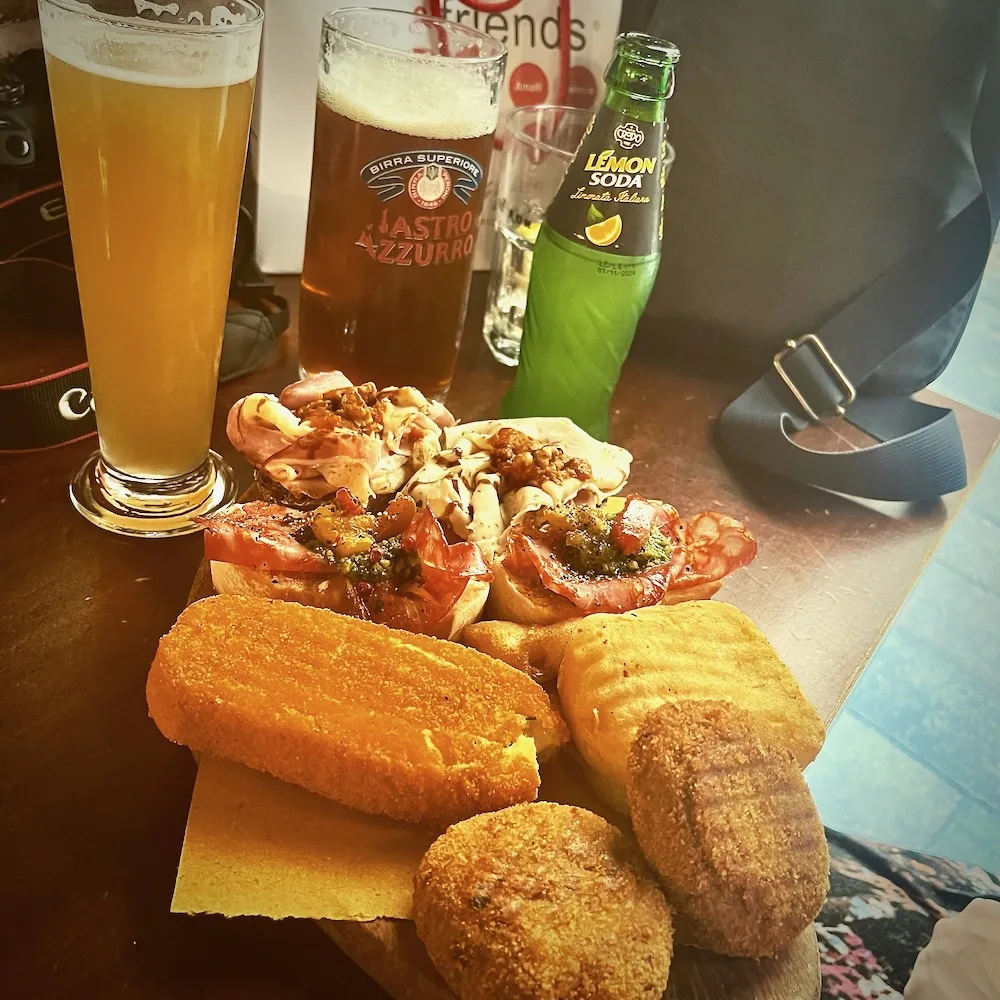
We read about a few cicchetterrias near the Rialto Bridge. When we passed by, their plates of cicchetti looked interesting and very good. But they were standing-room only and didn’t seem especially kid-friendly.
We found more low-key casual options strolling around San Polo, including one that had great local red and blonde lagers and another that had meat-stuffed fried olives that Teen Traveler loved.
Language tip: The word is pronounced Chikketty. The word that sounds like chichetty refers to a male body part and if you pronounce it that way, Venetians will giggle a bit.
Basic Information About Venice
Arriving by Air, Train or Car
If you drive to Venice you’ll have to park in public garages on Tronchetto, which is one of the first islands after you cross the bridge from the mainland. Trains go over the same bridge and end their journey near Cannaregio.
From either of these, you can take a Vaporetto or water taxi or walk to your hotel.
From Marco Polo Airport, you can take a train or a bus that will drop you at the station or in Tronchetto, respectively. You can also take an Alilaguna boat, which is the equivalent of express buses and make fewer stops than the Vaporettos.
There are also water taxis, which I talked about at the top of this post.
Getting Around Venice
The most common way to get around Venice is on the vaporettos (essentially, water buses). If you look online before you arrive it seems that you have to buy all-day passes, which can get expensive. But when you go to the vaporetto stops, the ticket machines have more options, including single rides.
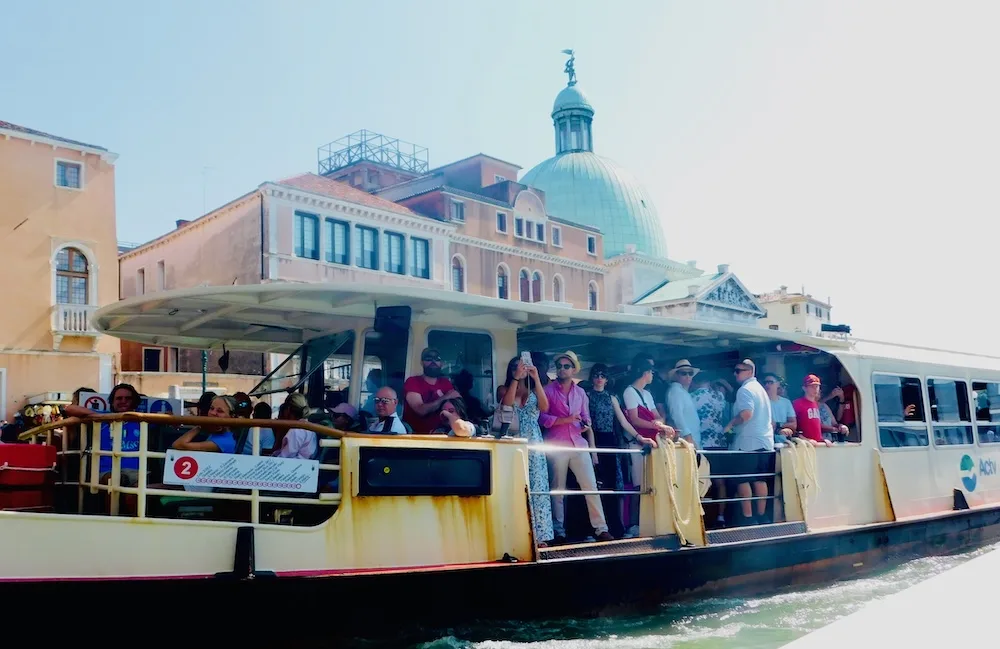
All the vaporettos follow routes around the central city and to neighboring islands like Giudecca. Boats going in both directions stop at the same docks. Pay close attention to the schedules and route numbers on the boats because it’s easy to go the wrong way.
Also, Venetians get priority boarding, which is reasonable. But at the busiest stops, tourists can wait a while for their turn.
If you want to visit the far outer islands, Alilaguna runs boats from a half-dozen stops in Central Venice to Murano, Burano and Torcello.
Walking Around Venice’s Neighborhoods
Every time you cross a bridge in Venice you are traversing from one island to another. There are more than 400 bridges connecting more than 100 tiny islands.
All the bridges have steps. The water taxis and vaporettos most likely won’t be able to drop you at your door, so pack luggage you don’t mind dragging up and down a lot of stairs.
The streets wind in a way that makes you think you’ll never find your way around. But after a few days we started to get a feel for navigating. There are signs all over directing you to St. Mark’s Square and the Rialto Bridge, so you can always find your way to those major landmarks. The thickest crowds are in the streets between these two major sights.
Central Venice is small and very walkable. It’s worth exploring Dorsoduro, San Polo, Santa Croce and Cannaregio. They’re still busy but not claustrophobically so. You’ll get a better feel for the city and stumble across interesting shops and local restaurants.
Unfortunately, many of these neighborhood places close for vacation in August. We sometimes had to default to the more touristy options because that’s what was open. Visiting in July would have given us some more and better options at times.
Kids and Venice
Venice is beautiful and mysterious and fantastic. I think kids from 7YO and up can get caught up in the maze of narrow streets, the bridges that lead to who-knows-what, and the ready availability of pasta, pizza and gelato. There are ways to make this city’s sights appealing to kids of all ages.

But Venice in summer is very hot and very crowded. On the narrowest streets we sometimes found this combination claustrophobic. It didn’t surprise us that many of the toddlers and preschoolers we passed in the heat of the day were crying.
We passed a few larger piazzas and saw a playground near the train station. But there’s no grass in Venice and not a lot of places where school-age kids can just run around and blow off steam.
Moreover, thanks to all those bridges, it’s not a stroller-friendly city. I heard one kid let out a loud “ayaa!” each time his mom bumped his stroller up or down a step. I could empathize with him.
I didn’t see a lot of small kids in carriers, which really surprised me. Carriers really seem the way to go, even for toddlers and preschoolers. It gets them above the crowd and makes it easier to navigate those narrow streets.
If I were visiting with little kids, I’d get family tours of the museums, spend a lot of early mornings wandering around the neighborhoods, ride a gondola and the vaporettos, and definitely return to my lodging for an afternoon nap.
I’d keep them hydrated with Italian soda. And we would eat a lot of cold, refreshing gelato. A LOT.
What To Pack For Venice
Plan to do a lot of walking in hot, humid weather on cobblestones, which are hard on your feet. Also plan on mosquitoes, which love all the alleys and squares that are protected from the wind.
European restaurants don’t serve tap water in restaurants, but Italian tap water is fine. Give everyone in your family a water bottle; you can keep everyone properly hydrated without paying for water all day.
Sunhats and sunglasses will come in handy.
Light long-sleeve tops can help with the sun and mosquitoes, as can long skirts, maxi dresses or light, baggy pants.
Comfortable and sturdy sandals or other light summer sneakers are a must.
Bring a big scarf in case you want to visit a church and need to cover up.
Baby powder and padded band-aids or mole skin can guard against the chafing and blisters you can face when walking around a lot in hot weather.
I packed a light cardigan for the evenings, but I never needed it.
In general, Americans dress far more casually than Europeans. When in doubt about what to wear to a restaurant, concert or church, dress up rather than down. You’re more likely to stand out for being too casual than for being too stylish.
Pack a camera. You’re going to want the best photos you can have from this trip and a phone doesn’t always cut it.
If you’re visiting in the fall or winter, pack a rain jacket and proper rain boots; city-wide flooding is the norm.
A tip for cellular service
Airalo is an app that provides virtual SIM cards, which allow you to access a local data network in the country you’re visiting without having to replace your physical SIM card. In the half-dozen countries where I’ve used Airalo, I’ve been able to get all the data I need for about $5/phone/week, compared with $10/phone/day in roaming fees with our carrier!
Pin it for later!
